ECOLOGICAL CONDITIONS OF BARKER’S CREEK CIRCUIT RESEARCH 2022
VerifiedAdded on 2022/09/27
|27
|4773
|19
Assignment
AI Summary
Scientific report: comparing plant ecosystemsYour scientific report will provide a thorough investigation of the differences between different habitat types encountered during the Noosa National Park field trip which will include wet and dry eucalypt forests, wallum, heathland and sand dune communities. You will quantitatively demonstrate to readers using figures, diagrams, maps, data tables and presenting statistical analyses the differences between these habitats using the data that will be collected as a class on the field trip.
Contribute Materials
Your contribution can guide someone’s learning journey. Share your
documents today.
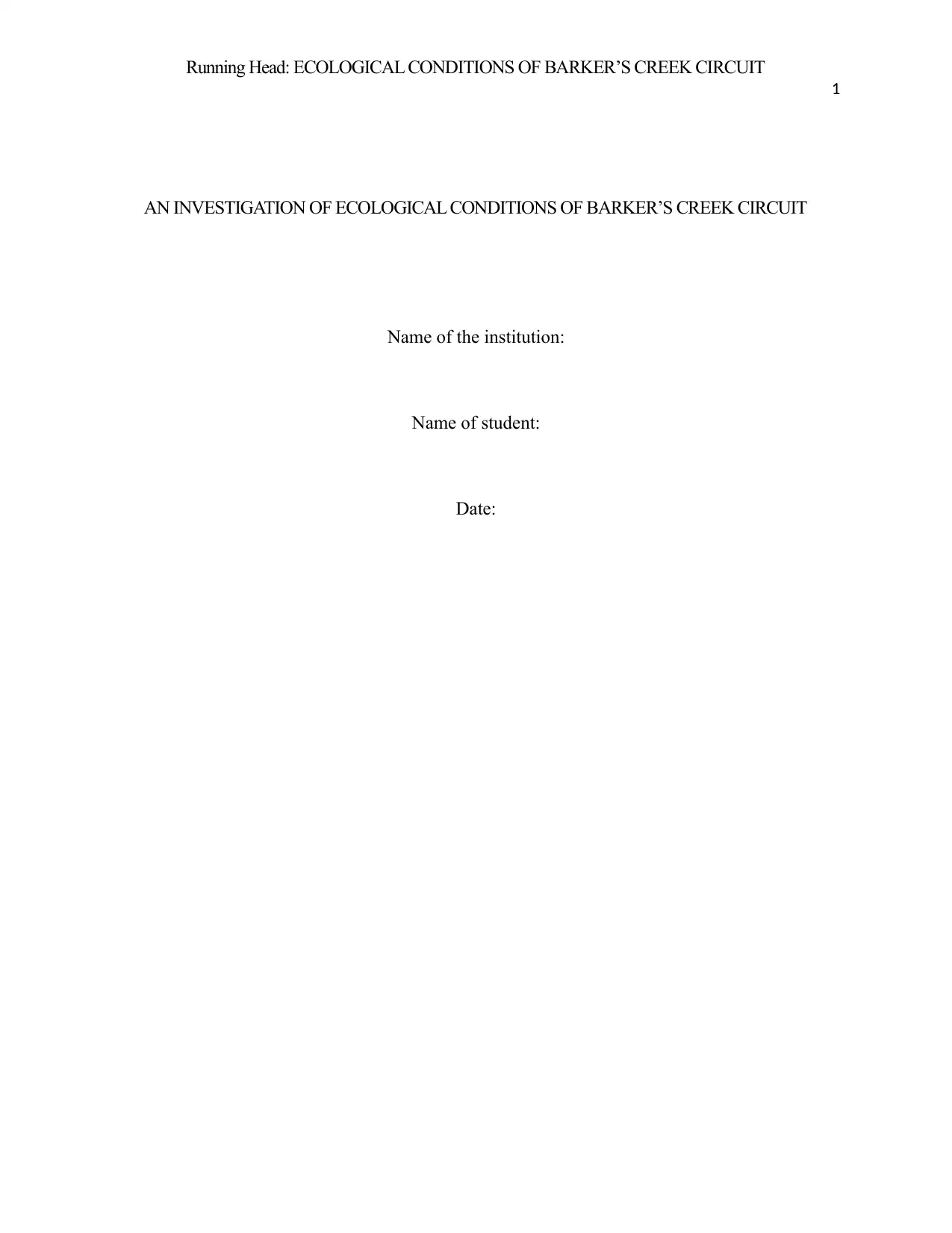
Running Head: ECOLOGICAL CONDITIONS OF BARKER’S CREEK CIRCUIT
1
AN INVESTIGATION OF ECOLOGICAL CONDITIONS OF BARKER’S CREEK CIRCUIT
Name of the institution:
Name of student:
Date:
1
AN INVESTIGATION OF ECOLOGICAL CONDITIONS OF BARKER’S CREEK CIRCUIT
Name of the institution:
Name of student:
Date:
Secure Best Marks with AI Grader
Need help grading? Try our AI Grader for instant feedback on your assignments.
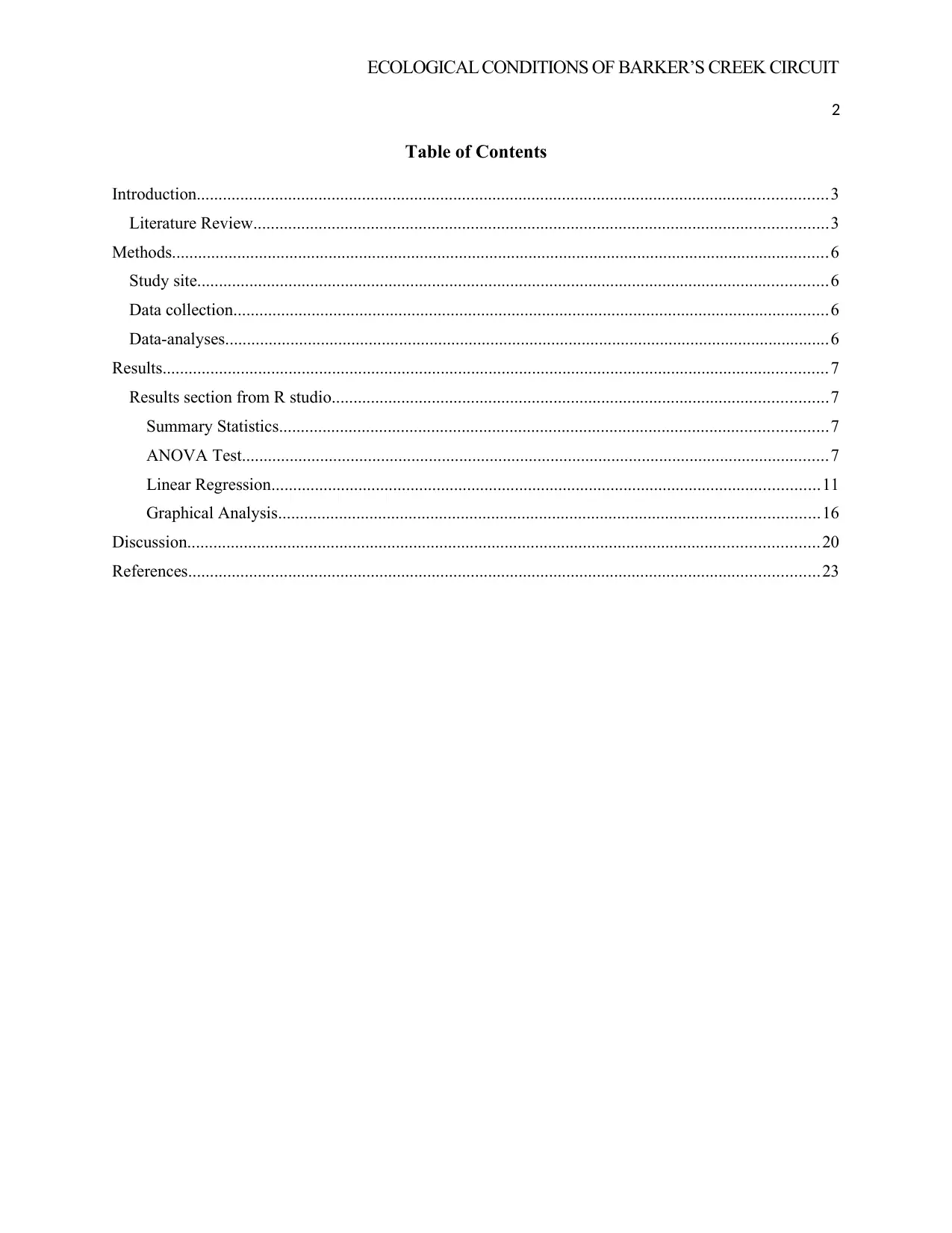
ECOLOGICAL CONDITIONS OF BARKER’S CREEK CIRCUIT
2
Table of Contents
Introduction.................................................................................................................................................3
Literature Review....................................................................................................................................3
Methods.......................................................................................................................................................6
Study site.................................................................................................................................................6
Data collection.........................................................................................................................................6
Data-analyses...........................................................................................................................................6
Results.........................................................................................................................................................7
Results section from R studio..................................................................................................................7
Summary Statistics..............................................................................................................................7
ANOVA Test.......................................................................................................................................7
Linear Regression..............................................................................................................................11
Graphical Analysis............................................................................................................................16
Discussion.................................................................................................................................................20
References.................................................................................................................................................23
2
Table of Contents
Introduction.................................................................................................................................................3
Literature Review....................................................................................................................................3
Methods.......................................................................................................................................................6
Study site.................................................................................................................................................6
Data collection.........................................................................................................................................6
Data-analyses...........................................................................................................................................6
Results.........................................................................................................................................................7
Results section from R studio..................................................................................................................7
Summary Statistics..............................................................................................................................7
ANOVA Test.......................................................................................................................................7
Linear Regression..............................................................................................................................11
Graphical Analysis............................................................................................................................16
Discussion.................................................................................................................................................20
References.................................................................................................................................................23
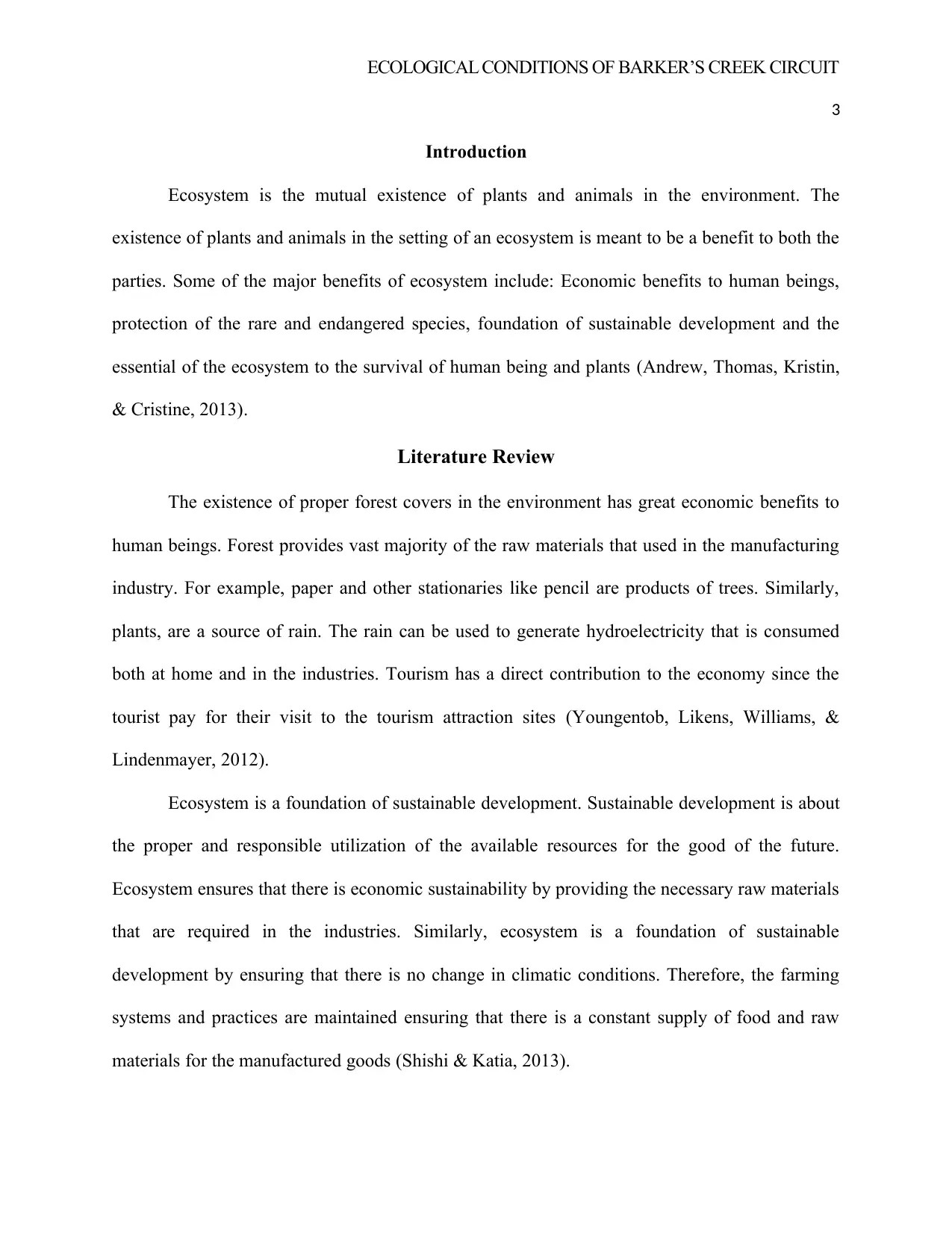
ECOLOGICAL CONDITIONS OF BARKER’S CREEK CIRCUIT
3
Introduction
Ecosystem is the mutual existence of plants and animals in the environment. The
existence of plants and animals in the setting of an ecosystem is meant to be a benefit to both the
parties. Some of the major benefits of ecosystem include: Economic benefits to human beings,
protection of the rare and endangered species, foundation of sustainable development and the
essential of the ecosystem to the survival of human being and plants (Andrew, Thomas, Kristin,
& Cristine, 2013).
Literature Review
The existence of proper forest covers in the environment has great economic benefits to
human beings. Forest provides vast majority of the raw materials that used in the manufacturing
industry. For example, paper and other stationaries like pencil are products of trees. Similarly,
plants, are a source of rain. The rain can be used to generate hydroelectricity that is consumed
both at home and in the industries. Tourism has a direct contribution to the economy since the
tourist pay for their visit to the tourism attraction sites (Youngentob, Likens, Williams, &
Lindenmayer, 2012).
Ecosystem is a foundation of sustainable development. Sustainable development is about
the proper and responsible utilization of the available resources for the good of the future.
Ecosystem ensures that there is economic sustainability by providing the necessary raw materials
that are required in the industries. Similarly, ecosystem is a foundation of sustainable
development by ensuring that there is no change in climatic conditions. Therefore, the farming
systems and practices are maintained ensuring that there is a constant supply of food and raw
materials for the manufactured goods (Shishi & Katia, 2013).
3
Introduction
Ecosystem is the mutual existence of plants and animals in the environment. The
existence of plants and animals in the setting of an ecosystem is meant to be a benefit to both the
parties. Some of the major benefits of ecosystem include: Economic benefits to human beings,
protection of the rare and endangered species, foundation of sustainable development and the
essential of the ecosystem to the survival of human being and plants (Andrew, Thomas, Kristin,
& Cristine, 2013).
Literature Review
The existence of proper forest covers in the environment has great economic benefits to
human beings. Forest provides vast majority of the raw materials that used in the manufacturing
industry. For example, paper and other stationaries like pencil are products of trees. Similarly,
plants, are a source of rain. The rain can be used to generate hydroelectricity that is consumed
both at home and in the industries. Tourism has a direct contribution to the economy since the
tourist pay for their visit to the tourism attraction sites (Youngentob, Likens, Williams, &
Lindenmayer, 2012).
Ecosystem is a foundation of sustainable development. Sustainable development is about
the proper and responsible utilization of the available resources for the good of the future.
Ecosystem ensures that there is economic sustainability by providing the necessary raw materials
that are required in the industries. Similarly, ecosystem is a foundation of sustainable
development by ensuring that there is no change in climatic conditions. Therefore, the farming
systems and practices are maintained ensuring that there is a constant supply of food and raw
materials for the manufactured goods (Shishi & Katia, 2013).
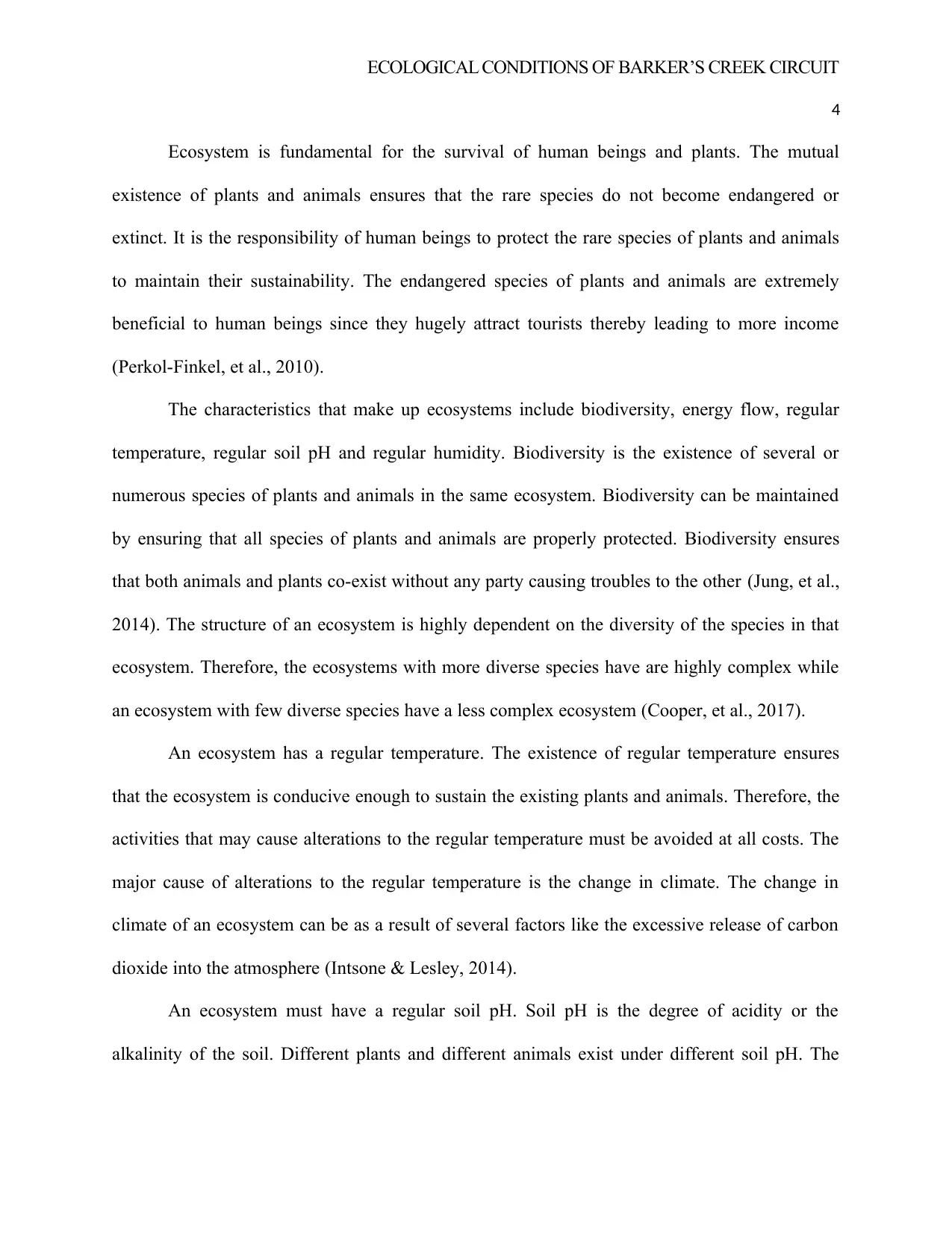
ECOLOGICAL CONDITIONS OF BARKER’S CREEK CIRCUIT
4
Ecosystem is fundamental for the survival of human beings and plants. The mutual
existence of plants and animals ensures that the rare species do not become endangered or
extinct. It is the responsibility of human beings to protect the rare species of plants and animals
to maintain their sustainability. The endangered species of plants and animals are extremely
beneficial to human beings since they hugely attract tourists thereby leading to more income
(Perkol-Finkel, et al., 2010).
The characteristics that make up ecosystems include biodiversity, energy flow, regular
temperature, regular soil pH and regular humidity. Biodiversity is the existence of several or
numerous species of plants and animals in the same ecosystem. Biodiversity can be maintained
by ensuring that all species of plants and animals are properly protected. Biodiversity ensures
that both animals and plants co-exist without any party causing troubles to the other (Jung, et al.,
2014). The structure of an ecosystem is highly dependent on the diversity of the species in that
ecosystem. Therefore, the ecosystems with more diverse species have are highly complex while
an ecosystem with few diverse species have a less complex ecosystem (Cooper, et al., 2017).
An ecosystem has a regular temperature. The existence of regular temperature ensures
that the ecosystem is conducive enough to sustain the existing plants and animals. Therefore, the
activities that may cause alterations to the regular temperature must be avoided at all costs. The
major cause of alterations to the regular temperature is the change in climate. The change in
climate of an ecosystem can be as a result of several factors like the excessive release of carbon
dioxide into the atmosphere (Intsone & Lesley, 2014).
An ecosystem must have a regular soil pH. Soil pH is the degree of acidity or the
alkalinity of the soil. Different plants and different animals exist under different soil pH. The
4
Ecosystem is fundamental for the survival of human beings and plants. The mutual
existence of plants and animals ensures that the rare species do not become endangered or
extinct. It is the responsibility of human beings to protect the rare species of plants and animals
to maintain their sustainability. The endangered species of plants and animals are extremely
beneficial to human beings since they hugely attract tourists thereby leading to more income
(Perkol-Finkel, et al., 2010).
The characteristics that make up ecosystems include biodiversity, energy flow, regular
temperature, regular soil pH and regular humidity. Biodiversity is the existence of several or
numerous species of plants and animals in the same ecosystem. Biodiversity can be maintained
by ensuring that all species of plants and animals are properly protected. Biodiversity ensures
that both animals and plants co-exist without any party causing troubles to the other (Jung, et al.,
2014). The structure of an ecosystem is highly dependent on the diversity of the species in that
ecosystem. Therefore, the ecosystems with more diverse species have are highly complex while
an ecosystem with few diverse species have a less complex ecosystem (Cooper, et al., 2017).
An ecosystem has a regular temperature. The existence of regular temperature ensures
that the ecosystem is conducive enough to sustain the existing plants and animals. Therefore, the
activities that may cause alterations to the regular temperature must be avoided at all costs. The
major cause of alterations to the regular temperature is the change in climate. The change in
climate of an ecosystem can be as a result of several factors like the excessive release of carbon
dioxide into the atmosphere (Intsone & Lesley, 2014).
An ecosystem must have a regular soil pH. Soil pH is the degree of acidity or the
alkalinity of the soil. Different plants and different animals exist under different soil pH. The
Secure Best Marks with AI Grader
Need help grading? Try our AI Grader for instant feedback on your assignments.
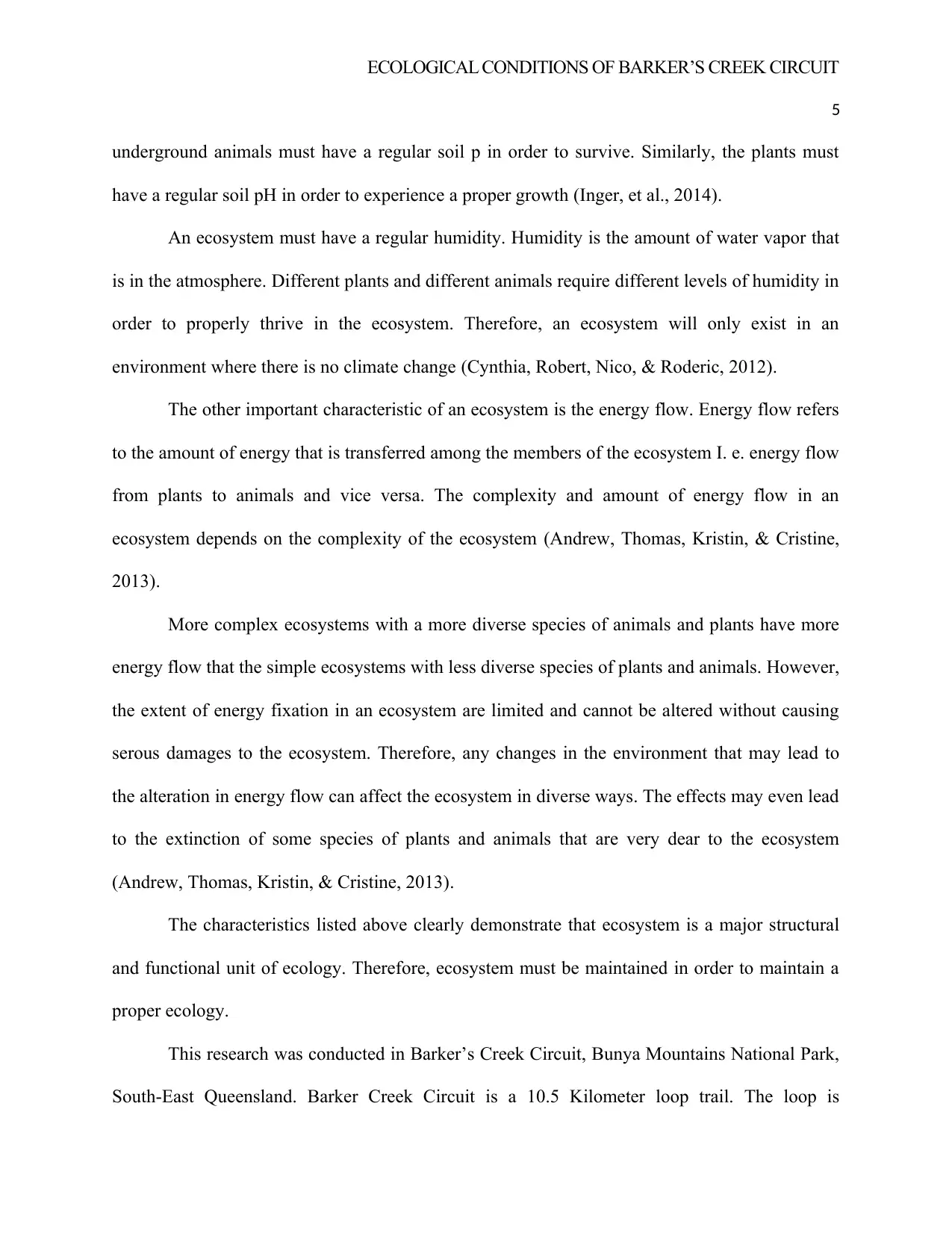
ECOLOGICAL CONDITIONS OF BARKER’S CREEK CIRCUIT
5
underground animals must have a regular soil p in order to survive. Similarly, the plants must
have a regular soil pH in order to experience a proper growth (Inger, et al., 2014).
An ecosystem must have a regular humidity. Humidity is the amount of water vapor that
is in the atmosphere. Different plants and different animals require different levels of humidity in
order to properly thrive in the ecosystem. Therefore, an ecosystem will only exist in an
environment where there is no climate change (Cynthia, Robert, Nico, & Roderic, 2012).
The other important characteristic of an ecosystem is the energy flow. Energy flow refers
to the amount of energy that is transferred among the members of the ecosystem I. e. energy flow
from plants to animals and vice versa. The complexity and amount of energy flow in an
ecosystem depends on the complexity of the ecosystem (Andrew, Thomas, Kristin, & Cristine,
2013).
More complex ecosystems with a more diverse species of animals and plants have more
energy flow that the simple ecosystems with less diverse species of plants and animals. However,
the extent of energy fixation in an ecosystem are limited and cannot be altered without causing
serous damages to the ecosystem. Therefore, any changes in the environment that may lead to
the alteration in energy flow can affect the ecosystem in diverse ways. The effects may even lead
to the extinction of some species of plants and animals that are very dear to the ecosystem
(Andrew, Thomas, Kristin, & Cristine, 2013).
The characteristics listed above clearly demonstrate that ecosystem is a major structural
and functional unit of ecology. Therefore, ecosystem must be maintained in order to maintain a
proper ecology.
This research was conducted in Barker’s Creek Circuit, Bunya Mountains National Park,
South-East Queensland. Barker Creek Circuit is a 10.5 Kilometer loop trail. The loop is
5
underground animals must have a regular soil p in order to survive. Similarly, the plants must
have a regular soil pH in order to experience a proper growth (Inger, et al., 2014).
An ecosystem must have a regular humidity. Humidity is the amount of water vapor that
is in the atmosphere. Different plants and different animals require different levels of humidity in
order to properly thrive in the ecosystem. Therefore, an ecosystem will only exist in an
environment where there is no climate change (Cynthia, Robert, Nico, & Roderic, 2012).
The other important characteristic of an ecosystem is the energy flow. Energy flow refers
to the amount of energy that is transferred among the members of the ecosystem I. e. energy flow
from plants to animals and vice versa. The complexity and amount of energy flow in an
ecosystem depends on the complexity of the ecosystem (Andrew, Thomas, Kristin, & Cristine,
2013).
More complex ecosystems with a more diverse species of animals and plants have more
energy flow that the simple ecosystems with less diverse species of plants and animals. However,
the extent of energy fixation in an ecosystem are limited and cannot be altered without causing
serous damages to the ecosystem. Therefore, any changes in the environment that may lead to
the alteration in energy flow can affect the ecosystem in diverse ways. The effects may even lead
to the extinction of some species of plants and animals that are very dear to the ecosystem
(Andrew, Thomas, Kristin, & Cristine, 2013).
The characteristics listed above clearly demonstrate that ecosystem is a major structural
and functional unit of ecology. Therefore, ecosystem must be maintained in order to maintain a
proper ecology.
This research was conducted in Barker’s Creek Circuit, Bunya Mountains National Park,
South-East Queensland. Barker Creek Circuit is a 10.5 Kilometer loop trail. The loop is
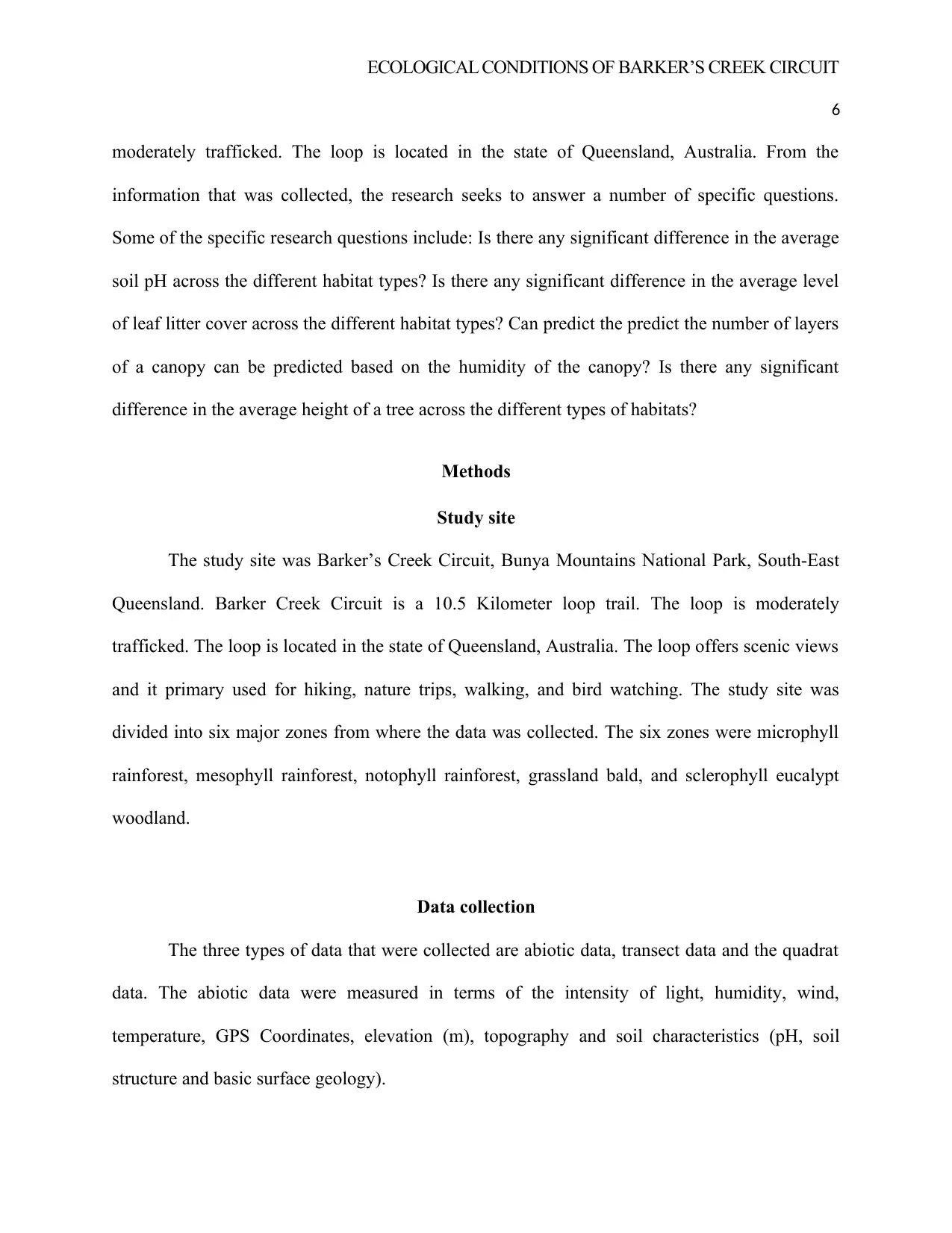
ECOLOGICAL CONDITIONS OF BARKER’S CREEK CIRCUIT
6
moderately trafficked. The loop is located in the state of Queensland, Australia. From the
information that was collected, the research seeks to answer a number of specific questions.
Some of the specific research questions include: Is there any significant difference in the average
soil pH across the different habitat types? Is there any significant difference in the average level
of leaf litter cover across the different habitat types? Can predict the predict the number of layers
of a canopy can be predicted based on the humidity of the canopy? Is there any significant
difference in the average height of a tree across the different types of habitats?
Methods
Study site
The study site was Barker’s Creek Circuit, Bunya Mountains National Park, South-East
Queensland. Barker Creek Circuit is a 10.5 Kilometer loop trail. The loop is moderately
trafficked. The loop is located in the state of Queensland, Australia. The loop offers scenic views
and it primary used for hiking, nature trips, walking, and bird watching. The study site was
divided into six major zones from where the data was collected. The six zones were microphyll
rainforest, mesophyll rainforest, notophyll rainforest, grassland bald, and sclerophyll eucalypt
woodland.
Data collection
The three types of data that were collected are abiotic data, transect data and the quadrat
data. The abiotic data were measured in terms of the intensity of light, humidity, wind,
temperature, GPS Coordinates, elevation (m), topography and soil characteristics (pH, soil
structure and basic surface geology).
6
moderately trafficked. The loop is located in the state of Queensland, Australia. From the
information that was collected, the research seeks to answer a number of specific questions.
Some of the specific research questions include: Is there any significant difference in the average
soil pH across the different habitat types? Is there any significant difference in the average level
of leaf litter cover across the different habitat types? Can predict the predict the number of layers
of a canopy can be predicted based on the humidity of the canopy? Is there any significant
difference in the average height of a tree across the different types of habitats?
Methods
Study site
The study site was Barker’s Creek Circuit, Bunya Mountains National Park, South-East
Queensland. Barker Creek Circuit is a 10.5 Kilometer loop trail. The loop is moderately
trafficked. The loop is located in the state of Queensland, Australia. The loop offers scenic views
and it primary used for hiking, nature trips, walking, and bird watching. The study site was
divided into six major zones from where the data was collected. The six zones were microphyll
rainforest, mesophyll rainforest, notophyll rainforest, grassland bald, and sclerophyll eucalypt
woodland.
Data collection
The three types of data that were collected are abiotic data, transect data and the quadrat
data. The abiotic data were measured in terms of the intensity of light, humidity, wind,
temperature, GPS Coordinates, elevation (m), topography and soil characteristics (pH, soil
structure and basic surface geology).
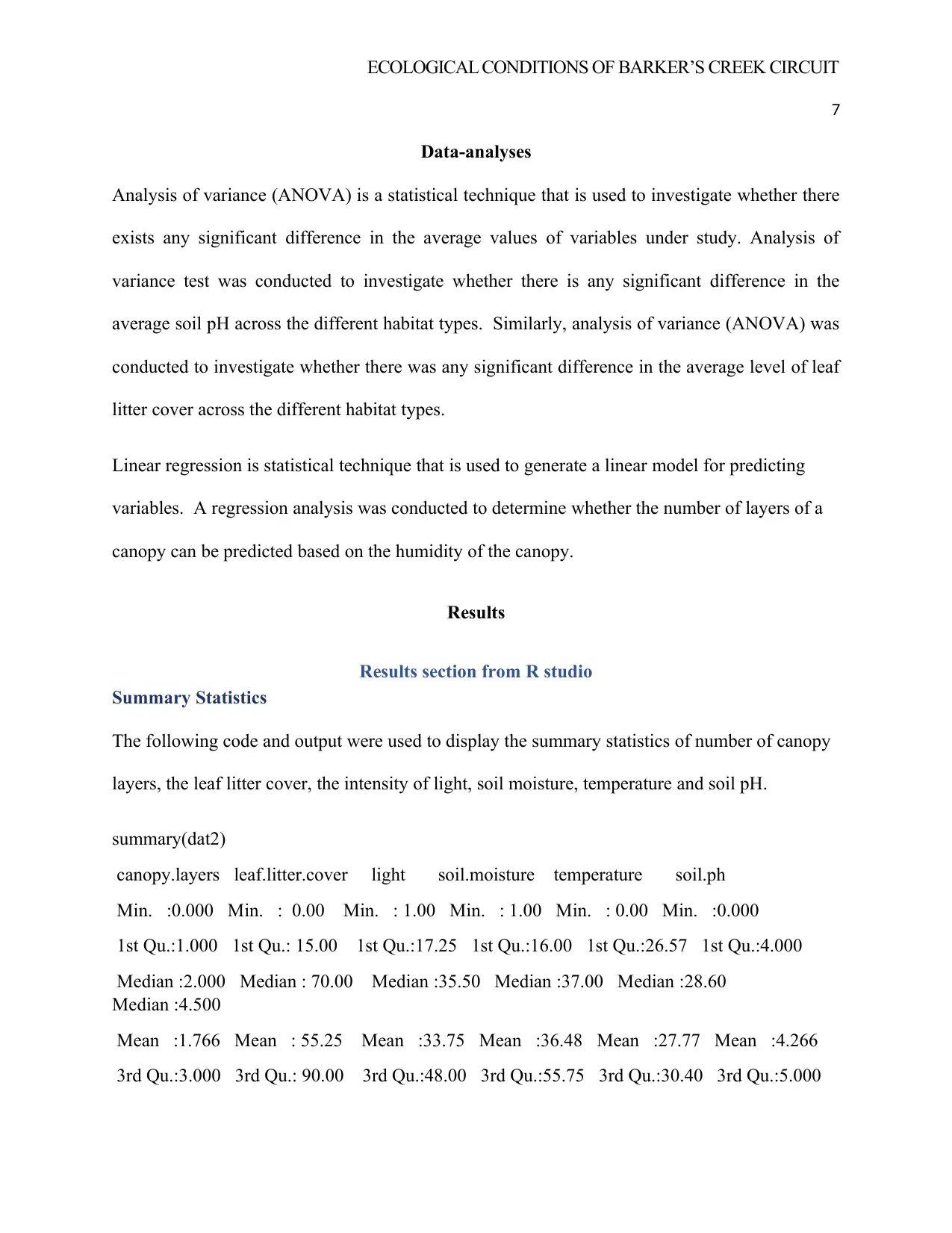
ECOLOGICAL CONDITIONS OF BARKER’S CREEK CIRCUIT
7
Data-analyses
Analysis of variance (ANOVA) is a statistical technique that is used to investigate whether there
exists any significant difference in the average values of variables under study. Analysis of
variance test was conducted to investigate whether there is any significant difference in the
average soil pH across the different habitat types. Similarly, analysis of variance (ANOVA) was
conducted to investigate whether there was any significant difference in the average level of leaf
litter cover across the different habitat types.
Linear regression is statistical technique that is used to generate a linear model for predicting
variables. A regression analysis was conducted to determine whether the number of layers of a
canopy can be predicted based on the humidity of the canopy.
Results
Results section from R studio
Summary Statistics
The following code and output were used to display the summary statistics of number of canopy
layers, the leaf litter cover, the intensity of light, soil moisture, temperature and soil pH.
summary(dat2)
canopy.layers leaf.litter.cover light soil.moisture temperature soil.ph
Min. :0.000 Min. : 0.00 Min. : 1.00 Min. : 1.00 Min. : 0.00 Min. :0.000
1st Qu.:1.000 1st Qu.: 15.00 1st Qu.:17.25 1st Qu.:16.00 1st Qu.:26.57 1st Qu.:4.000
Median :2.000 Median : 70.00 Median :35.50 Median :37.00 Median :28.60
Median :4.500
Mean :1.766 Mean : 55.25 Mean :33.75 Mean :36.48 Mean :27.77 Mean :4.266
3rd Qu.:3.000 3rd Qu.: 90.00 3rd Qu.:48.00 3rd Qu.:55.75 3rd Qu.:30.40 3rd Qu.:5.000
7
Data-analyses
Analysis of variance (ANOVA) is a statistical technique that is used to investigate whether there
exists any significant difference in the average values of variables under study. Analysis of
variance test was conducted to investigate whether there is any significant difference in the
average soil pH across the different habitat types. Similarly, analysis of variance (ANOVA) was
conducted to investigate whether there was any significant difference in the average level of leaf
litter cover across the different habitat types.
Linear regression is statistical technique that is used to generate a linear model for predicting
variables. A regression analysis was conducted to determine whether the number of layers of a
canopy can be predicted based on the humidity of the canopy.
Results
Results section from R studio
Summary Statistics
The following code and output were used to display the summary statistics of number of canopy
layers, the leaf litter cover, the intensity of light, soil moisture, temperature and soil pH.
summary(dat2)
canopy.layers leaf.litter.cover light soil.moisture temperature soil.ph
Min. :0.000 Min. : 0.00 Min. : 1.00 Min. : 1.00 Min. : 0.00 Min. :0.000
1st Qu.:1.000 1st Qu.: 15.00 1st Qu.:17.25 1st Qu.:16.00 1st Qu.:26.57 1st Qu.:4.000
Median :2.000 Median : 70.00 Median :35.50 Median :37.00 Median :28.60
Median :4.500
Mean :1.766 Mean : 55.25 Mean :33.75 Mean :36.48 Mean :27.77 Mean :4.266
3rd Qu.:3.000 3rd Qu.: 90.00 3rd Qu.:48.00 3rd Qu.:55.75 3rd Qu.:30.40 3rd Qu.:5.000
Paraphrase This Document
Need a fresh take? Get an instant paraphrase of this document with our AI Paraphraser
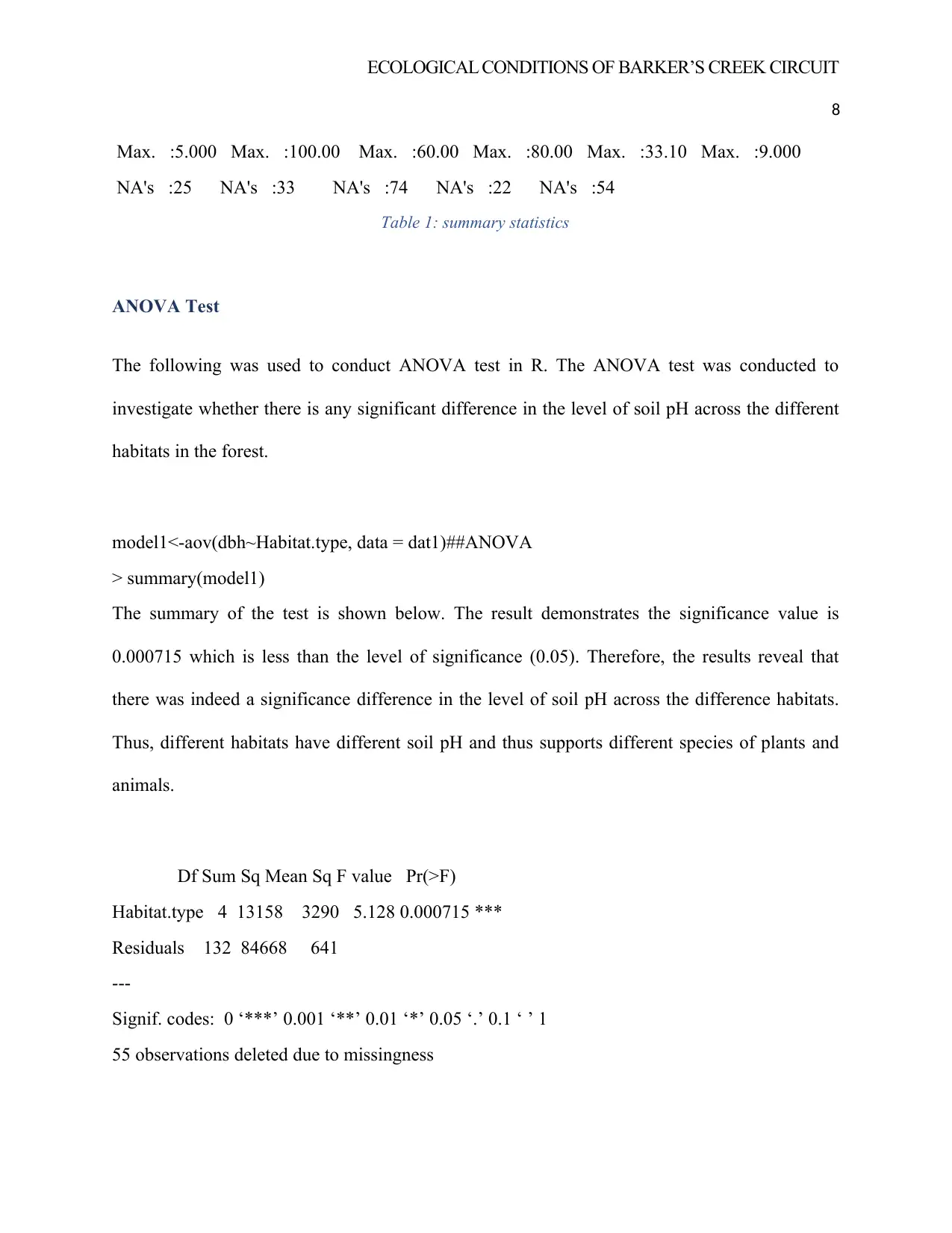
ECOLOGICAL CONDITIONS OF BARKER’S CREEK CIRCUIT
8
Max. :5.000 Max. :100.00 Max. :60.00 Max. :80.00 Max. :33.10 Max. :9.000
NA's :25 NA's :33 NA's :74 NA's :22 NA's :54
Table 1: summary statistics
ANOVA Test
The following was used to conduct ANOVA test in R. The ANOVA test was conducted to
investigate whether there is any significant difference in the level of soil pH across the different
habitats in the forest.
model1<-aov(dbh~Habitat.type, data = dat1)##ANOVA
> summary(model1)
The summary of the test is shown below. The result demonstrates the significance value is
0.000715 which is less than the level of significance (0.05). Therefore, the results reveal that
there was indeed a significance difference in the level of soil pH across the difference habitats.
Thus, different habitats have different soil pH and thus supports different species of plants and
animals.
Df Sum Sq Mean Sq F value Pr(>F)
Habitat.type 4 13158 3290 5.128 0.000715 ***
Residuals 132 84668 641
---
Signif. codes: 0 ‘***’ 0.001 ‘**’ 0.01 ‘*’ 0.05 ‘.’ 0.1 ‘ ’ 1
55 observations deleted due to missingness
8
Max. :5.000 Max. :100.00 Max. :60.00 Max. :80.00 Max. :33.10 Max. :9.000
NA's :25 NA's :33 NA's :74 NA's :22 NA's :54
Table 1: summary statistics
ANOVA Test
The following was used to conduct ANOVA test in R. The ANOVA test was conducted to
investigate whether there is any significant difference in the level of soil pH across the different
habitats in the forest.
model1<-aov(dbh~Habitat.type, data = dat1)##ANOVA
> summary(model1)
The summary of the test is shown below. The result demonstrates the significance value is
0.000715 which is less than the level of significance (0.05). Therefore, the results reveal that
there was indeed a significance difference in the level of soil pH across the difference habitats.
Thus, different habitats have different soil pH and thus supports different species of plants and
animals.
Df Sum Sq Mean Sq F value Pr(>F)
Habitat.type 4 13158 3290 5.128 0.000715 ***
Residuals 132 84668 641
---
Signif. codes: 0 ‘***’ 0.001 ‘**’ 0.01 ‘*’ 0.05 ‘.’ 0.1 ‘ ’ 1
55 observations deleted due to missingness
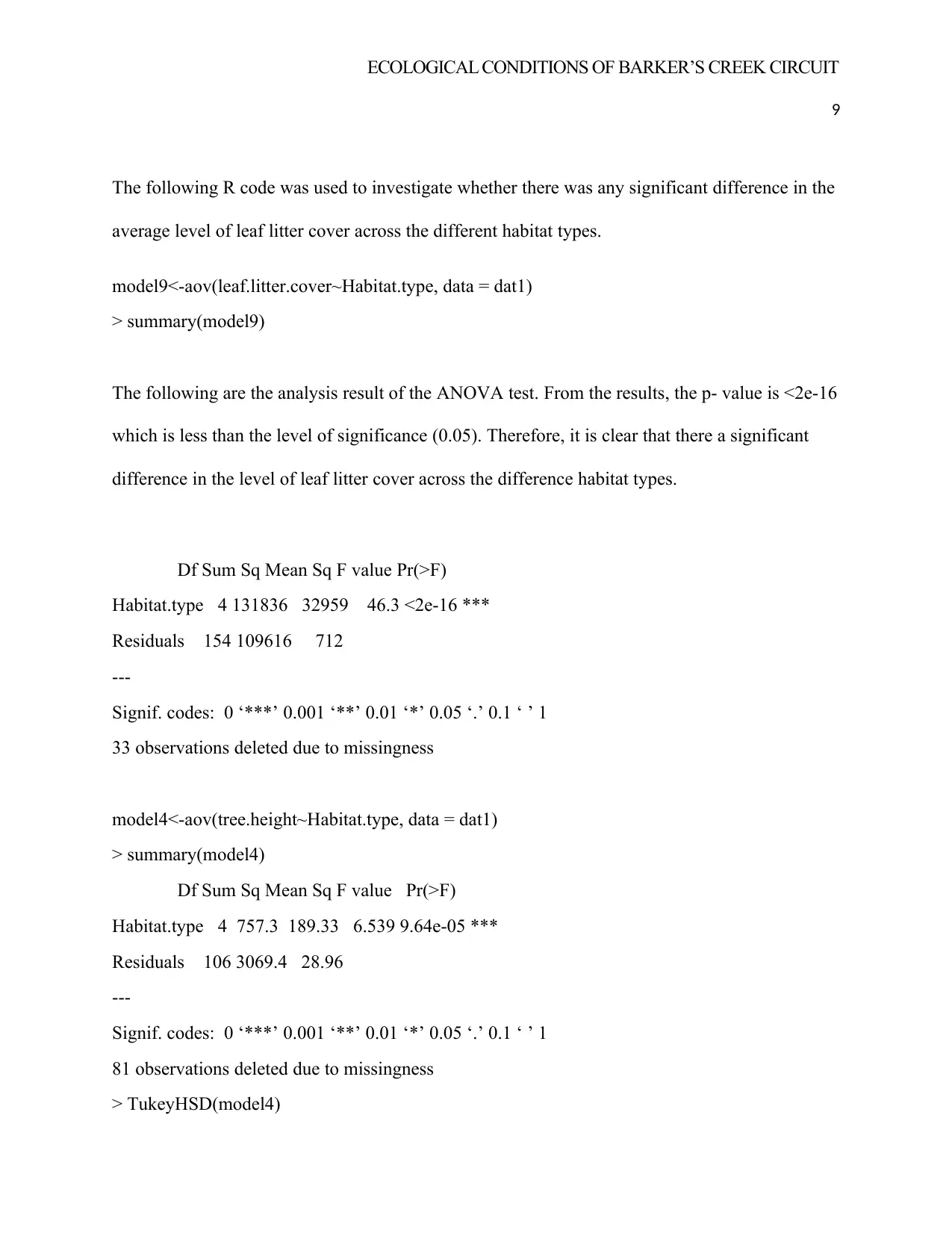
ECOLOGICAL CONDITIONS OF BARKER’S CREEK CIRCUIT
9
The following R code was used to investigate whether there was any significant difference in the
average level of leaf litter cover across the different habitat types.
model9<-aov(leaf.litter.cover~Habitat.type, data = dat1)
> summary(model9)
The following are the analysis result of the ANOVA test. From the results, the p- value is <2e-16
which is less than the level of significance (0.05). Therefore, it is clear that there a significant
difference in the level of leaf litter cover across the difference habitat types.
Df Sum Sq Mean Sq F value Pr(>F)
Habitat.type 4 131836 32959 46.3 <2e-16 ***
Residuals 154 109616 712
---
Signif. codes: 0 ‘***’ 0.001 ‘**’ 0.01 ‘*’ 0.05 ‘.’ 0.1 ‘ ’ 1
33 observations deleted due to missingness
model4<-aov(tree.height~Habitat.type, data = dat1)
> summary(model4)
Df Sum Sq Mean Sq F value Pr(>F)
Habitat.type 4 757.3 189.33 6.539 9.64e-05 ***
Residuals 106 3069.4 28.96
---
Signif. codes: 0 ‘***’ 0.001 ‘**’ 0.01 ‘*’ 0.05 ‘.’ 0.1 ‘ ’ 1
81 observations deleted due to missingness
> TukeyHSD(model4)
9
The following R code was used to investigate whether there was any significant difference in the
average level of leaf litter cover across the different habitat types.
model9<-aov(leaf.litter.cover~Habitat.type, data = dat1)
> summary(model9)
The following are the analysis result of the ANOVA test. From the results, the p- value is <2e-16
which is less than the level of significance (0.05). Therefore, it is clear that there a significant
difference in the level of leaf litter cover across the difference habitat types.
Df Sum Sq Mean Sq F value Pr(>F)
Habitat.type 4 131836 32959 46.3 <2e-16 ***
Residuals 154 109616 712
---
Signif. codes: 0 ‘***’ 0.001 ‘**’ 0.01 ‘*’ 0.05 ‘.’ 0.1 ‘ ’ 1
33 observations deleted due to missingness
model4<-aov(tree.height~Habitat.type, data = dat1)
> summary(model4)
Df Sum Sq Mean Sq F value Pr(>F)
Habitat.type 4 757.3 189.33 6.539 9.64e-05 ***
Residuals 106 3069.4 28.96
---
Signif. codes: 0 ‘***’ 0.001 ‘**’ 0.01 ‘*’ 0.05 ‘.’ 0.1 ‘ ’ 1
81 observations deleted due to missingness
> TukeyHSD(model4)
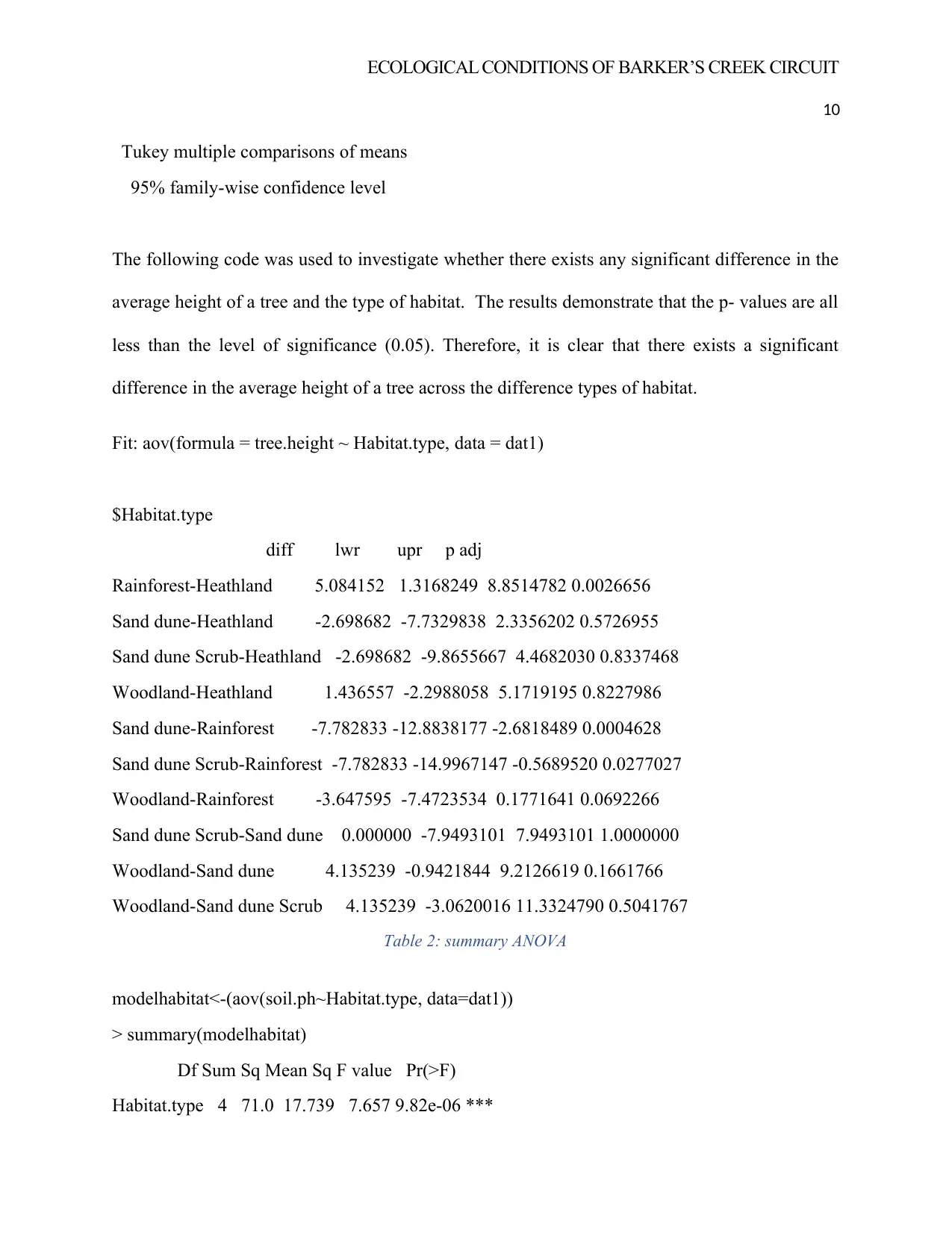
ECOLOGICAL CONDITIONS OF BARKER’S CREEK CIRCUIT
10
Tukey multiple comparisons of means
95% family-wise confidence level
The following code was used to investigate whether there exists any significant difference in the
average height of a tree and the type of habitat. The results demonstrate that the p- values are all
less than the level of significance (0.05). Therefore, it is clear that there exists a significant
difference in the average height of a tree across the difference types of habitat.
Fit: aov(formula = tree.height ~ Habitat.type, data = dat1)
$Habitat.type
diff lwr upr p adj
Rainforest-Heathland 5.084152 1.3168249 8.8514782 0.0026656
Sand dune-Heathland -2.698682 -7.7329838 2.3356202 0.5726955
Sand dune Scrub-Heathland -2.698682 -9.8655667 4.4682030 0.8337468
Woodland-Heathland 1.436557 -2.2988058 5.1719195 0.8227986
Sand dune-Rainforest -7.782833 -12.8838177 -2.6818489 0.0004628
Sand dune Scrub-Rainforest -7.782833 -14.9967147 -0.5689520 0.0277027
Woodland-Rainforest -3.647595 -7.4723534 0.1771641 0.0692266
Sand dune Scrub-Sand dune 0.000000 -7.9493101 7.9493101 1.0000000
Woodland-Sand dune 4.135239 -0.9421844 9.2126619 0.1661766
Woodland-Sand dune Scrub 4.135239 -3.0620016 11.3324790 0.5041767
Table 2: summary ANOVA
modelhabitat<-(aov(soil.ph~Habitat.type, data=dat1))
> summary(modelhabitat)
Df Sum Sq Mean Sq F value Pr(>F)
Habitat.type 4 71.0 17.739 7.657 9.82e-06 ***
10
Tukey multiple comparisons of means
95% family-wise confidence level
The following code was used to investigate whether there exists any significant difference in the
average height of a tree and the type of habitat. The results demonstrate that the p- values are all
less than the level of significance (0.05). Therefore, it is clear that there exists a significant
difference in the average height of a tree across the difference types of habitat.
Fit: aov(formula = tree.height ~ Habitat.type, data = dat1)
$Habitat.type
diff lwr upr p adj
Rainforest-Heathland 5.084152 1.3168249 8.8514782 0.0026656
Sand dune-Heathland -2.698682 -7.7329838 2.3356202 0.5726955
Sand dune Scrub-Heathland -2.698682 -9.8655667 4.4682030 0.8337468
Woodland-Heathland 1.436557 -2.2988058 5.1719195 0.8227986
Sand dune-Rainforest -7.782833 -12.8838177 -2.6818489 0.0004628
Sand dune Scrub-Rainforest -7.782833 -14.9967147 -0.5689520 0.0277027
Woodland-Rainforest -3.647595 -7.4723534 0.1771641 0.0692266
Sand dune Scrub-Sand dune 0.000000 -7.9493101 7.9493101 1.0000000
Woodland-Sand dune 4.135239 -0.9421844 9.2126619 0.1661766
Woodland-Sand dune Scrub 4.135239 -3.0620016 11.3324790 0.5041767
Table 2: summary ANOVA
modelhabitat<-(aov(soil.ph~Habitat.type, data=dat1))
> summary(modelhabitat)
Df Sum Sq Mean Sq F value Pr(>F)
Habitat.type 4 71.0 17.739 7.657 9.82e-06 ***
Secure Best Marks with AI Grader
Need help grading? Try our AI Grader for instant feedback on your assignments.
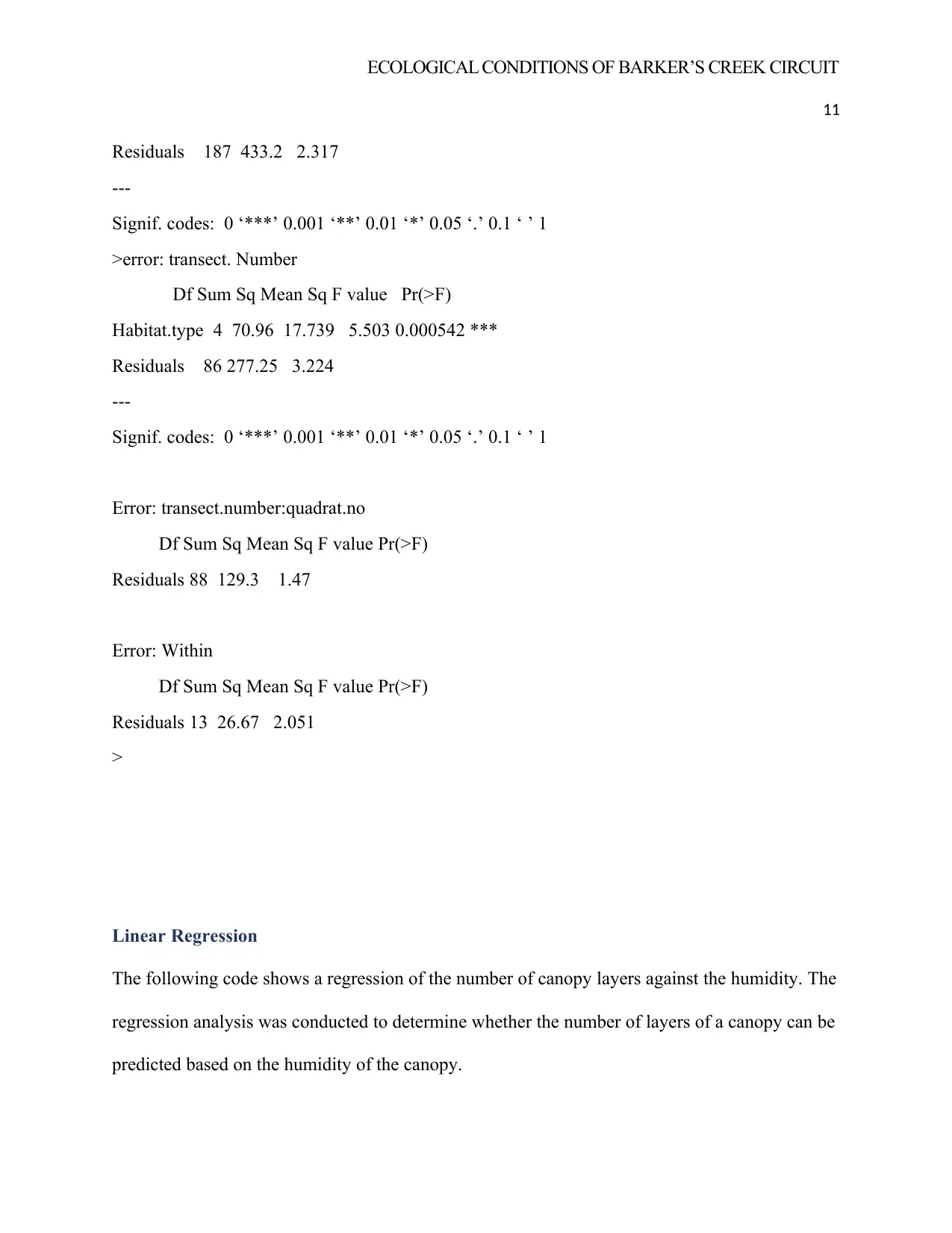
ECOLOGICAL CONDITIONS OF BARKER’S CREEK CIRCUIT
11
Residuals 187 433.2 2.317
---
Signif. codes: 0 ‘***’ 0.001 ‘**’ 0.01 ‘*’ 0.05 ‘.’ 0.1 ‘ ’ 1
>error: transect. Number
Df Sum Sq Mean Sq F value Pr(>F)
Habitat.type 4 70.96 17.739 5.503 0.000542 ***
Residuals 86 277.25 3.224
---
Signif. codes: 0 ‘***’ 0.001 ‘**’ 0.01 ‘*’ 0.05 ‘.’ 0.1 ‘ ’ 1
Error: transect.number:quadrat.no
Df Sum Sq Mean Sq F value Pr(>F)
Residuals 88 129.3 1.47
Error: Within
Df Sum Sq Mean Sq F value Pr(>F)
Residuals 13 26.67 2.051
>
Linear Regression
The following code shows a regression of the number of canopy layers against the humidity. The
regression analysis was conducted to determine whether the number of layers of a canopy can be
predicted based on the humidity of the canopy.
11
Residuals 187 433.2 2.317
---
Signif. codes: 0 ‘***’ 0.001 ‘**’ 0.01 ‘*’ 0.05 ‘.’ 0.1 ‘ ’ 1
>error: transect. Number
Df Sum Sq Mean Sq F value Pr(>F)
Habitat.type 4 70.96 17.739 5.503 0.000542 ***
Residuals 86 277.25 3.224
---
Signif. codes: 0 ‘***’ 0.001 ‘**’ 0.01 ‘*’ 0.05 ‘.’ 0.1 ‘ ’ 1
Error: transect.number:quadrat.no
Df Sum Sq Mean Sq F value Pr(>F)
Residuals 88 129.3 1.47
Error: Within
Df Sum Sq Mean Sq F value Pr(>F)
Residuals 13 26.67 2.051
>
Linear Regression
The following code shows a regression of the number of canopy layers against the humidity. The
regression analysis was conducted to determine whether the number of layers of a canopy can be
predicted based on the humidity of the canopy.
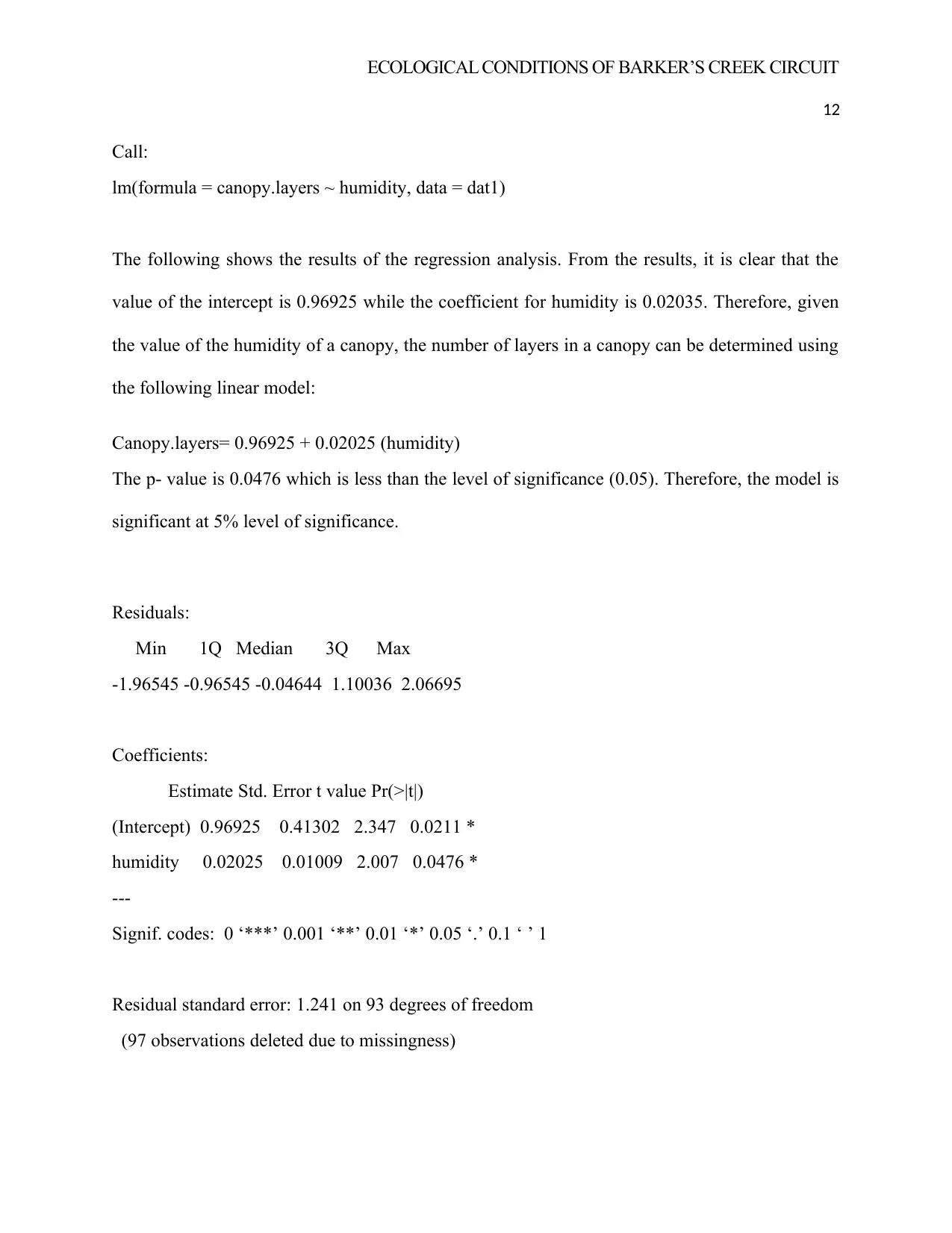
ECOLOGICAL CONDITIONS OF BARKER’S CREEK CIRCUIT
12
Call:
lm(formula = canopy.layers ~ humidity, data = dat1)
The following shows the results of the regression analysis. From the results, it is clear that the
value of the intercept is 0.96925 while the coefficient for humidity is 0.02035. Therefore, given
the value of the humidity of a canopy, the number of layers in a canopy can be determined using
the following linear model:
Canopy.layers= 0.96925 + 0.02025 (humidity)
The p- value is 0.0476 which is less than the level of significance (0.05). Therefore, the model is
significant at 5% level of significance.
Residuals:
Min 1Q Median 3Q Max
-1.96545 -0.96545 -0.04644 1.10036 2.06695
Coefficients:
Estimate Std. Error t value Pr(>|t|)
(Intercept) 0.96925 0.41302 2.347 0.0211 *
humidity 0.02025 0.01009 2.007 0.0476 *
---
Signif. codes: 0 ‘***’ 0.001 ‘**’ 0.01 ‘*’ 0.05 ‘.’ 0.1 ‘ ’ 1
Residual standard error: 1.241 on 93 degrees of freedom
(97 observations deleted due to missingness)
12
Call:
lm(formula = canopy.layers ~ humidity, data = dat1)
The following shows the results of the regression analysis. From the results, it is clear that the
value of the intercept is 0.96925 while the coefficient for humidity is 0.02035. Therefore, given
the value of the humidity of a canopy, the number of layers in a canopy can be determined using
the following linear model:
Canopy.layers= 0.96925 + 0.02025 (humidity)
The p- value is 0.0476 which is less than the level of significance (0.05). Therefore, the model is
significant at 5% level of significance.
Residuals:
Min 1Q Median 3Q Max
-1.96545 -0.96545 -0.04644 1.10036 2.06695
Coefficients:
Estimate Std. Error t value Pr(>|t|)
(Intercept) 0.96925 0.41302 2.347 0.0211 *
humidity 0.02025 0.01009 2.007 0.0476 *
---
Signif. codes: 0 ‘***’ 0.001 ‘**’ 0.01 ‘*’ 0.05 ‘.’ 0.1 ‘ ’ 1
Residual standard error: 1.241 on 93 degrees of freedom
(97 observations deleted due to missingness)
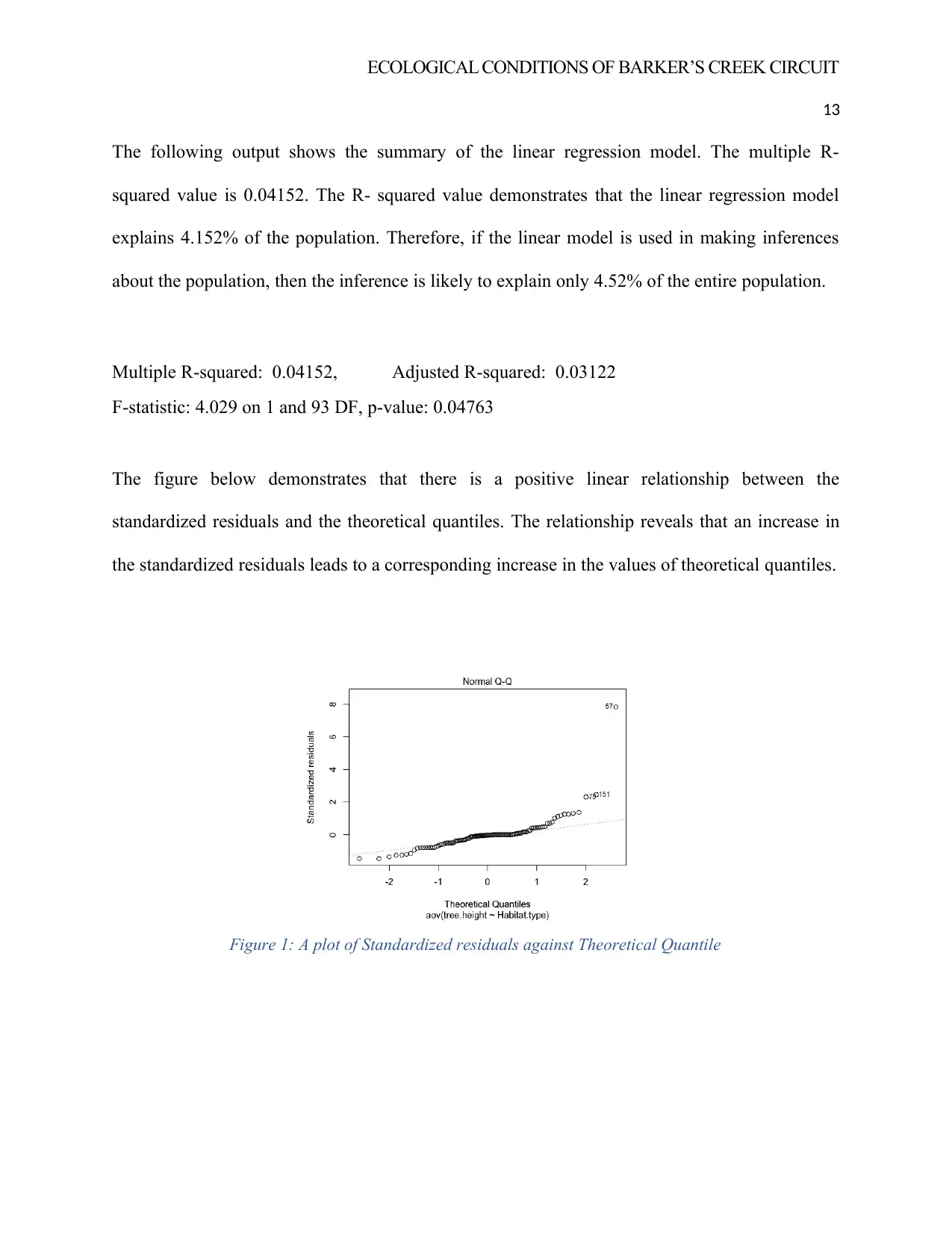
ECOLOGICAL CONDITIONS OF BARKER’S CREEK CIRCUIT
13
The following output shows the summary of the linear regression model. The multiple R-
squared value is 0.04152. The R- squared value demonstrates that the linear regression model
explains 4.152% of the population. Therefore, if the linear model is used in making inferences
about the population, then the inference is likely to explain only 4.52% of the entire population.
Multiple R-squared: 0.04152, Adjusted R-squared: 0.03122
F-statistic: 4.029 on 1 and 93 DF, p-value: 0.04763
The figure below demonstrates that there is a positive linear relationship between the
standardized residuals and the theoretical quantiles. The relationship reveals that an increase in
the standardized residuals leads to a corresponding increase in the values of theoretical quantiles.
Figure 1: A plot of Standardized residuals against Theoretical Quantile
13
The following output shows the summary of the linear regression model. The multiple R-
squared value is 0.04152. The R- squared value demonstrates that the linear regression model
explains 4.152% of the population. Therefore, if the linear model is used in making inferences
about the population, then the inference is likely to explain only 4.52% of the entire population.
Multiple R-squared: 0.04152, Adjusted R-squared: 0.03122
F-statistic: 4.029 on 1 and 93 DF, p-value: 0.04763
The figure below demonstrates that there is a positive linear relationship between the
standardized residuals and the theoretical quantiles. The relationship reveals that an increase in
the standardized residuals leads to a corresponding increase in the values of theoretical quantiles.
Figure 1: A plot of Standardized residuals against Theoretical Quantile
Paraphrase This Document
Need a fresh take? Get an instant paraphrase of this document with our AI Paraphraser
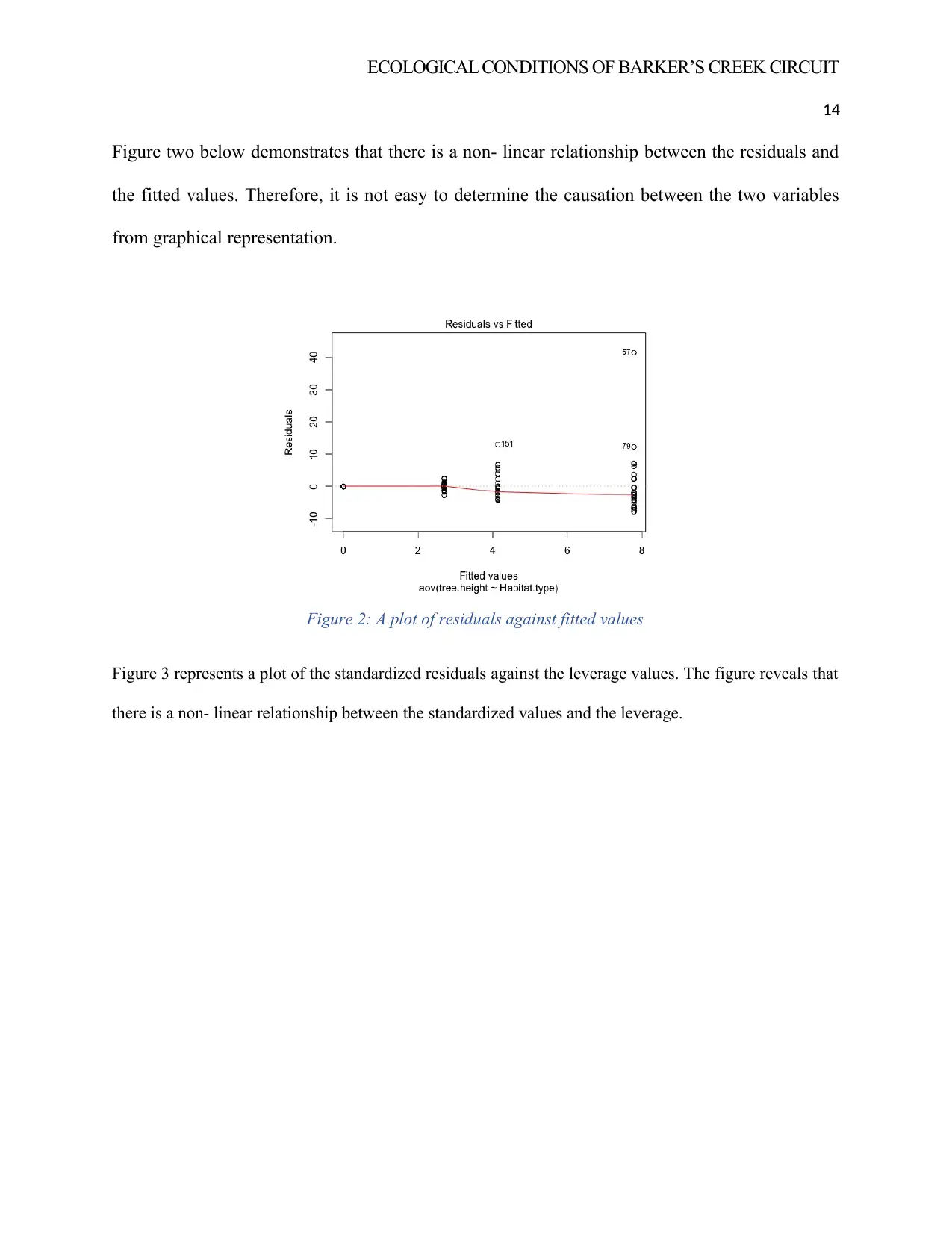
ECOLOGICAL CONDITIONS OF BARKER’S CREEK CIRCUIT
14
Figure two below demonstrates that there is a non- linear relationship between the residuals and
the fitted values. Therefore, it is not easy to determine the causation between the two variables
from graphical representation.
Figure 2: A plot of residuals against fitted values
Figure 3 represents a plot of the standardized residuals against the leverage values. The figure reveals that
there is a non- linear relationship between the standardized values and the leverage.
14
Figure two below demonstrates that there is a non- linear relationship between the residuals and
the fitted values. Therefore, it is not easy to determine the causation between the two variables
from graphical representation.
Figure 2: A plot of residuals against fitted values
Figure 3 represents a plot of the standardized residuals against the leverage values. The figure reveals that
there is a non- linear relationship between the standardized values and the leverage.
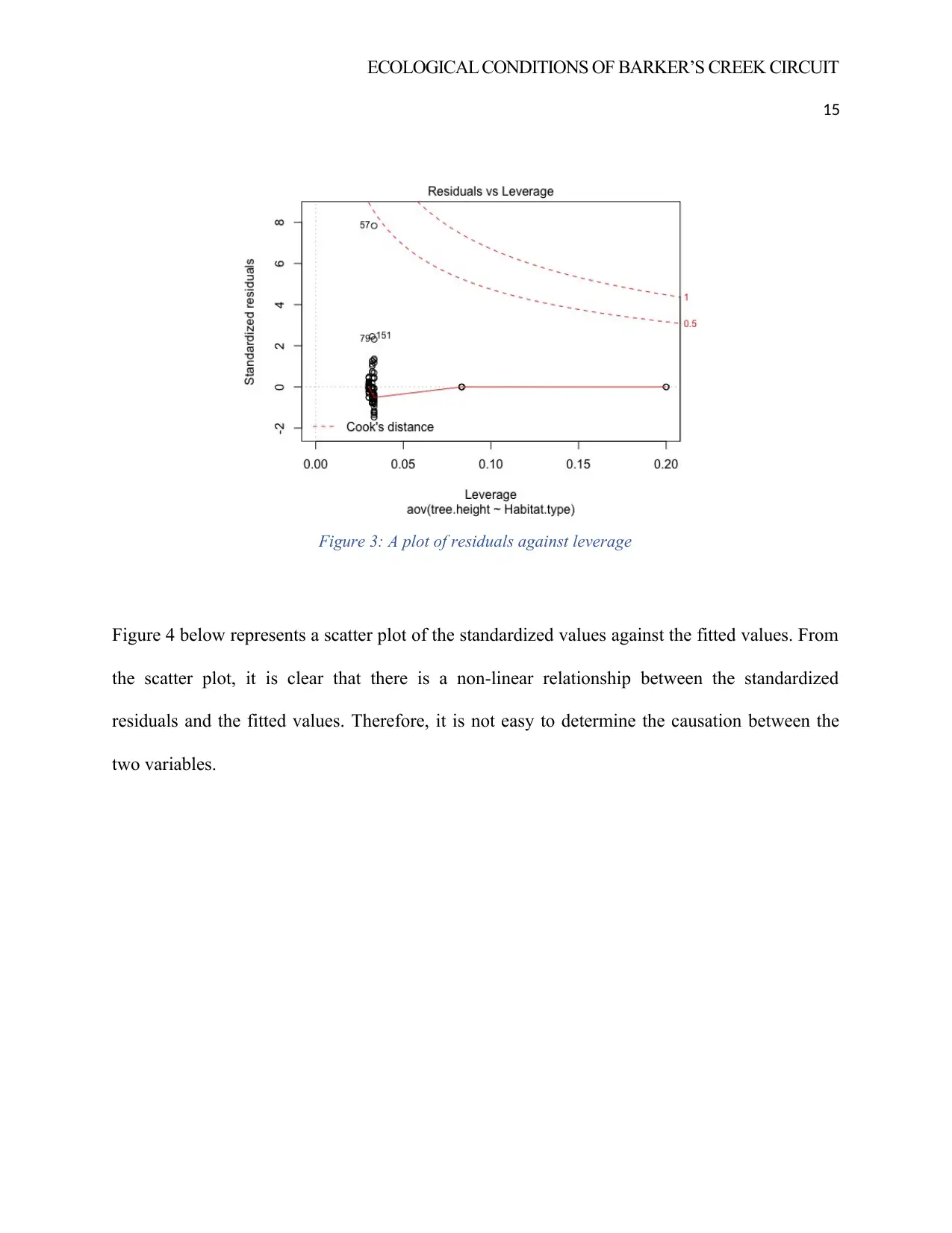
ECOLOGICAL CONDITIONS OF BARKER’S CREEK CIRCUIT
15
Figure 3: A plot of residuals against leverage
Figure 4 below represents a scatter plot of the standardized values against the fitted values. From
the scatter plot, it is clear that there is a non-linear relationship between the standardized
residuals and the fitted values. Therefore, it is not easy to determine the causation between the
two variables.
15
Figure 3: A plot of residuals against leverage
Figure 4 below represents a scatter plot of the standardized values against the fitted values. From
the scatter plot, it is clear that there is a non-linear relationship between the standardized
residuals and the fitted values. Therefore, it is not easy to determine the causation between the
two variables.
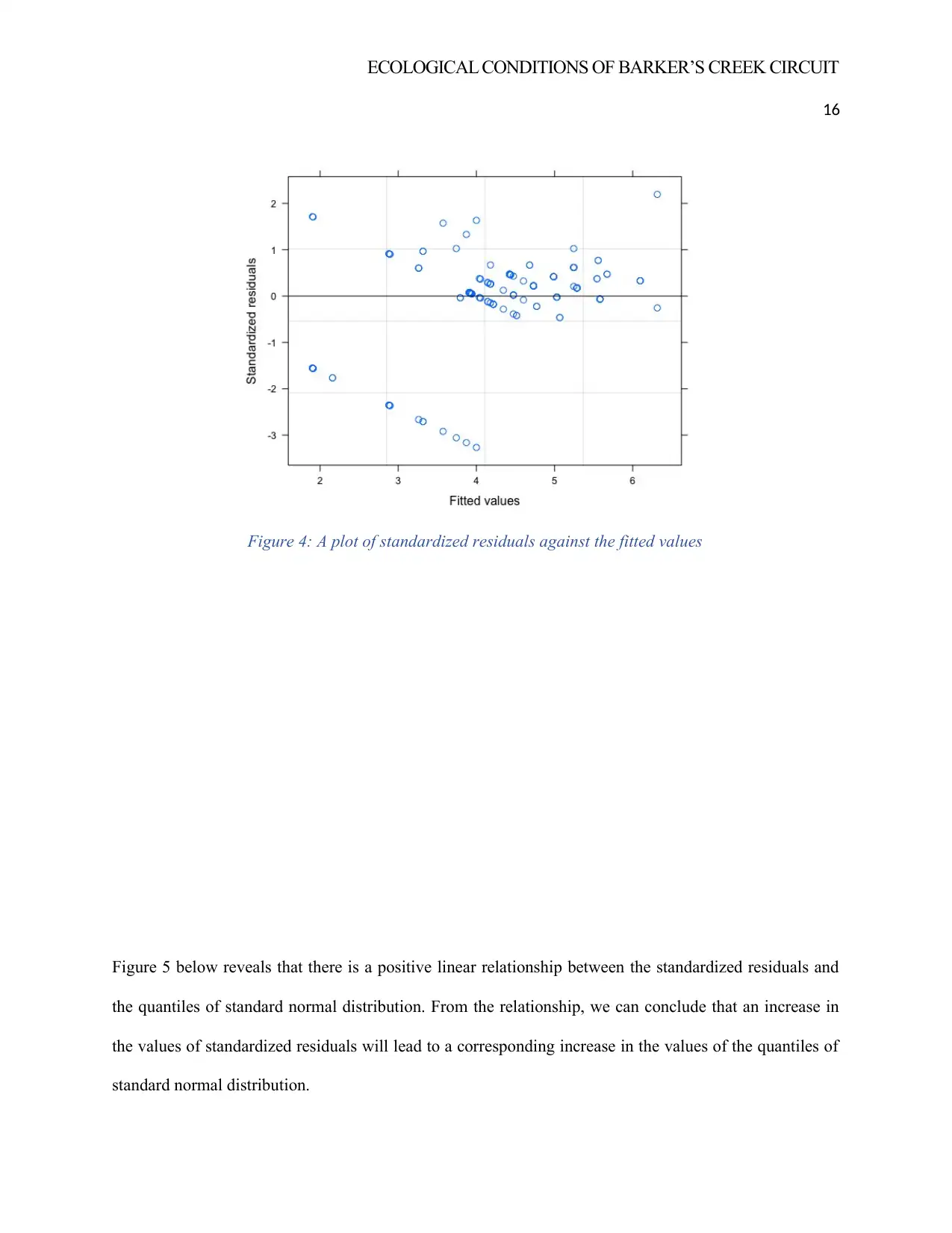
ECOLOGICAL CONDITIONS OF BARKER’S CREEK CIRCUIT
16
Figure 4: A plot of standardized residuals against the fitted values
Figure 5 below reveals that there is a positive linear relationship between the standardized residuals and
the quantiles of standard normal distribution. From the relationship, we can conclude that an increase in
the values of standardized residuals will lead to a corresponding increase in the values of the quantiles of
standard normal distribution.
16
Figure 4: A plot of standardized residuals against the fitted values
Figure 5 below reveals that there is a positive linear relationship between the standardized residuals and
the quantiles of standard normal distribution. From the relationship, we can conclude that an increase in
the values of standardized residuals will lead to a corresponding increase in the values of the quantiles of
standard normal distribution.
Secure Best Marks with AI Grader
Need help grading? Try our AI Grader for instant feedback on your assignments.
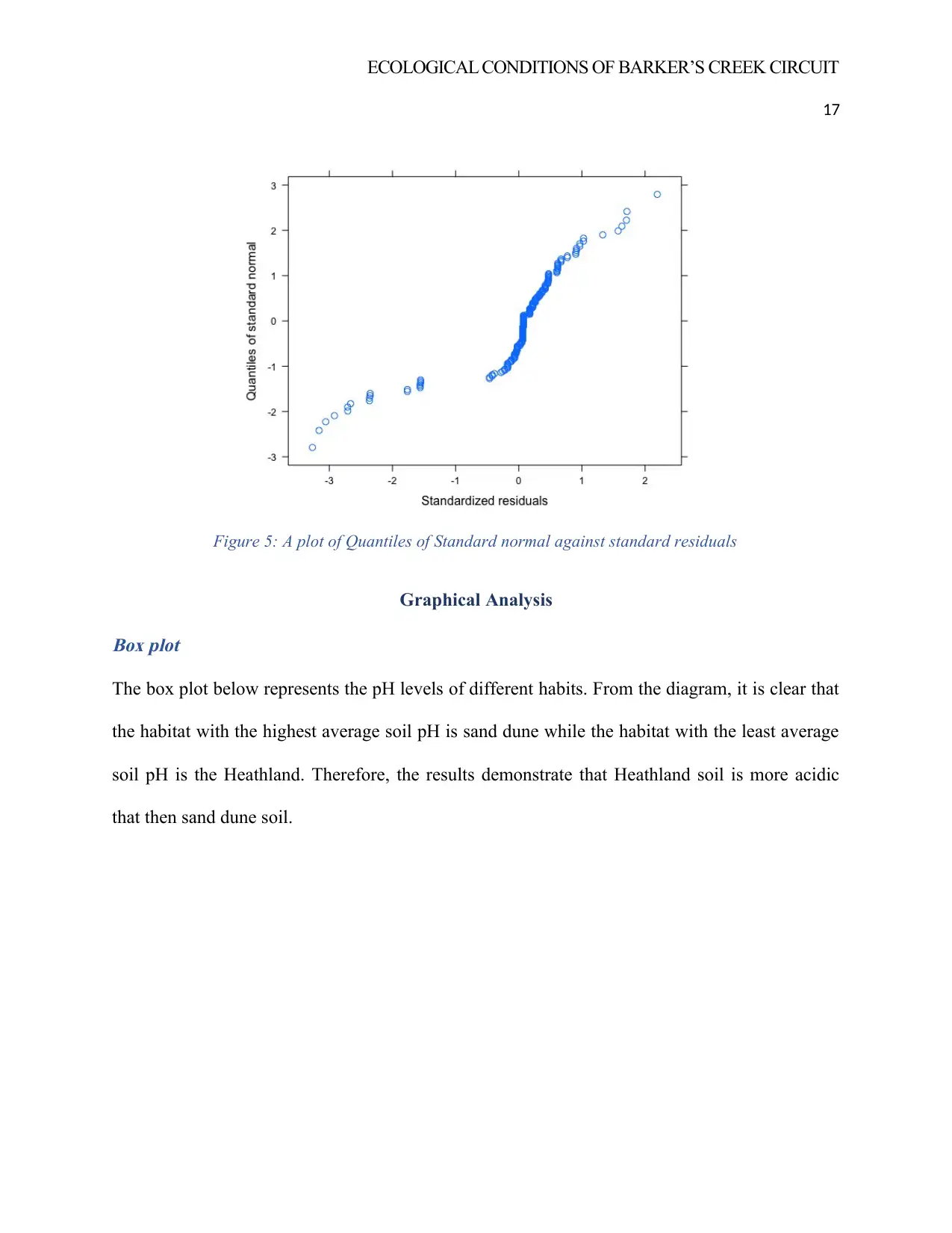
ECOLOGICAL CONDITIONS OF BARKER’S CREEK CIRCUIT
17
Figure 5: A plot of Quantiles of Standard normal against standard residuals
Graphical Analysis
Box plot
The box plot below represents the pH levels of different habits. From the diagram, it is clear that
the habitat with the highest average soil pH is sand dune while the habitat with the least average
soil pH is the Heathland. Therefore, the results demonstrate that Heathland soil is more acidic
that then sand dune soil.
17
Figure 5: A plot of Quantiles of Standard normal against standard residuals
Graphical Analysis
Box plot
The box plot below represents the pH levels of different habits. From the diagram, it is clear that
the habitat with the highest average soil pH is sand dune while the habitat with the least average
soil pH is the Heathland. Therefore, the results demonstrate that Heathland soil is more acidic
that then sand dune soil.
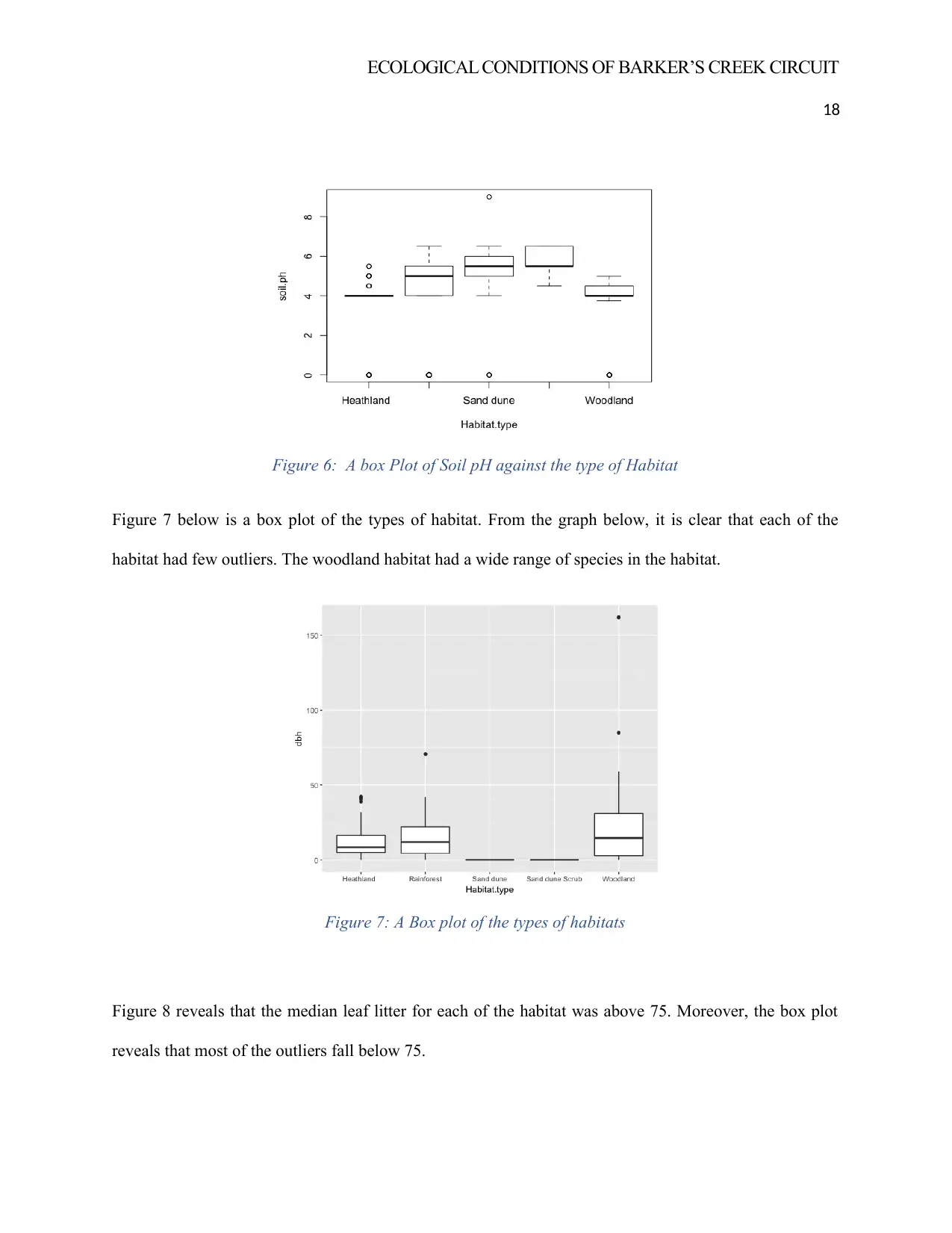
ECOLOGICAL CONDITIONS OF BARKER’S CREEK CIRCUIT
18
Figure 6: A box Plot of Soil pH against the type of Habitat
Figure 7 below is a box plot of the types of habitat. From the graph below, it is clear that each of the
habitat had few outliers. The woodland habitat had a wide range of species in the habitat.
Figure 7: A Box plot of the types of habitats
Figure 8 reveals that the median leaf litter for each of the habitat was above 75. Moreover, the box plot
reveals that most of the outliers fall below 75.
18
Figure 6: A box Plot of Soil pH against the type of Habitat
Figure 7 below is a box plot of the types of habitat. From the graph below, it is clear that each of the
habitat had few outliers. The woodland habitat had a wide range of species in the habitat.
Figure 7: A Box plot of the types of habitats
Figure 8 reveals that the median leaf litter for each of the habitat was above 75. Moreover, the box plot
reveals that most of the outliers fall below 75.
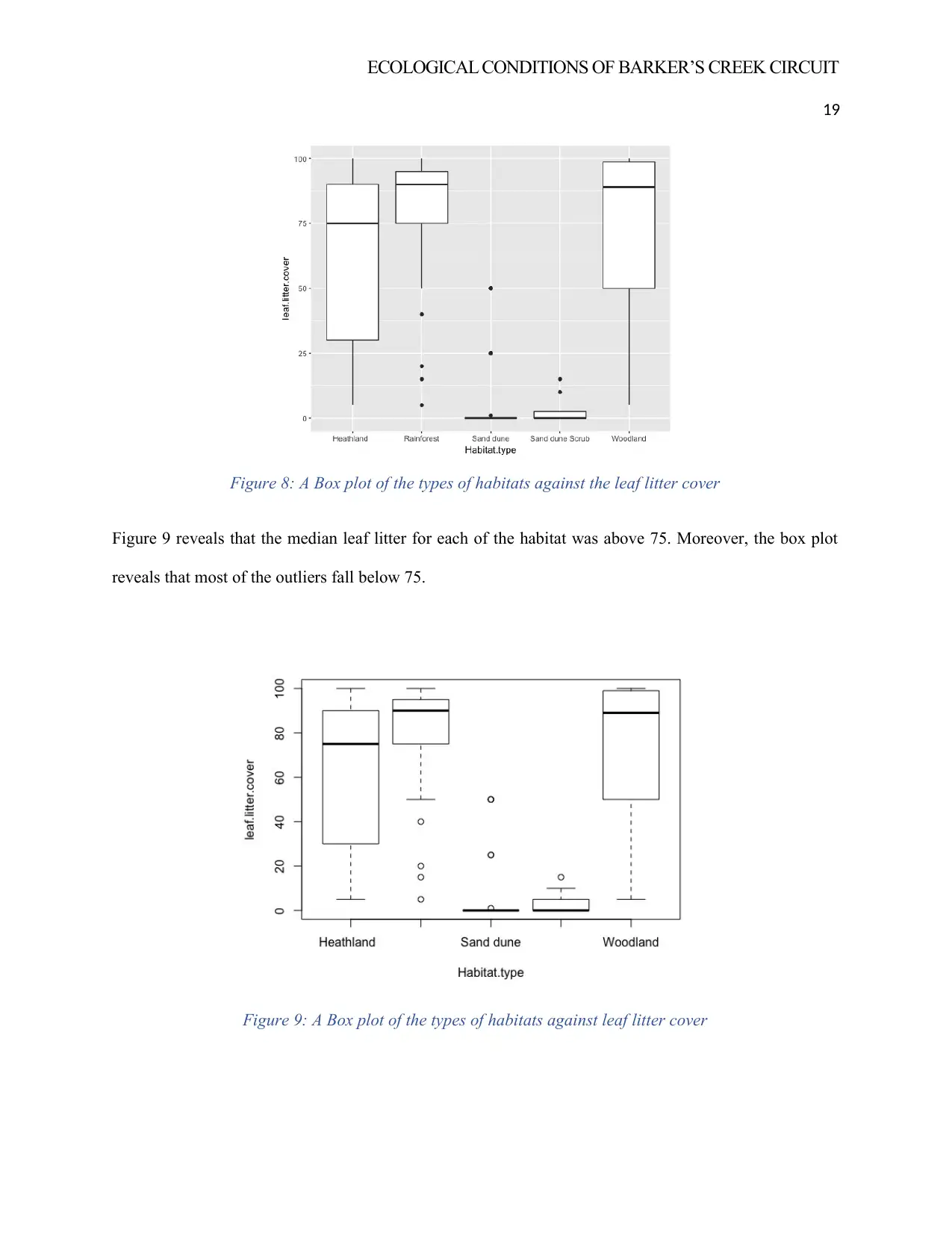
ECOLOGICAL CONDITIONS OF BARKER’S CREEK CIRCUIT
19
Figure 8: A Box plot of the types of habitats against the leaf litter cover
Figure 9 reveals that the median leaf litter for each of the habitat was above 75. Moreover, the box plot
reveals that most of the outliers fall below 75.
Figure 9: A Box plot of the types of habitats against leaf litter cover
19
Figure 8: A Box plot of the types of habitats against the leaf litter cover
Figure 9 reveals that the median leaf litter for each of the habitat was above 75. Moreover, the box plot
reveals that most of the outliers fall below 75.
Figure 9: A Box plot of the types of habitats against leaf litter cover
Paraphrase This Document
Need a fresh take? Get an instant paraphrase of this document with our AI Paraphraser
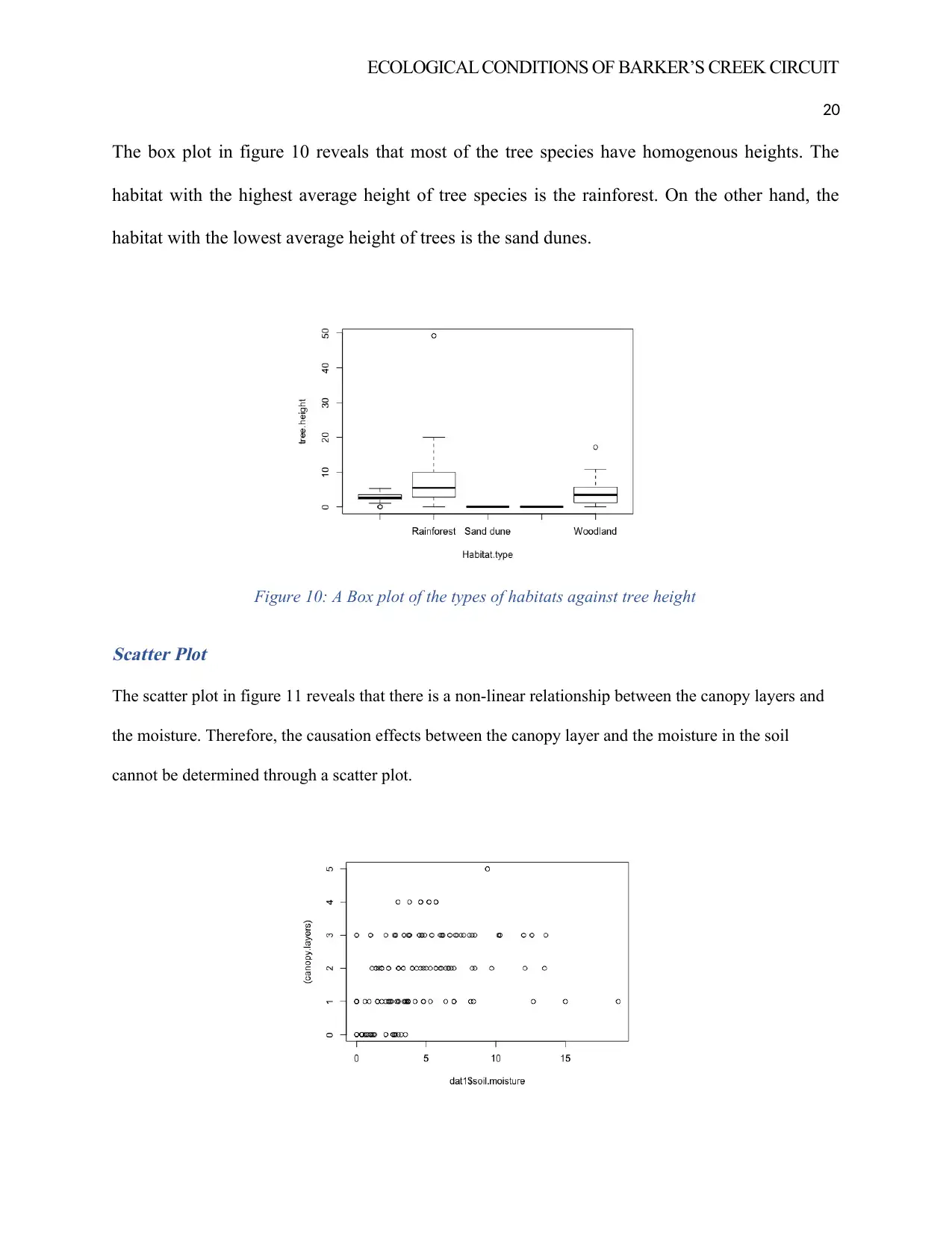
ECOLOGICAL CONDITIONS OF BARKER’S CREEK CIRCUIT
20
The box plot in figure 10 reveals that most of the tree species have homogenous heights. The
habitat with the highest average height of tree species is the rainforest. On the other hand, the
habitat with the lowest average height of trees is the sand dunes.
Figure 10: A Box plot of the types of habitats against tree height
Scatter Plot
The scatter plot in figure 11 reveals that there is a non-linear relationship between the canopy layers and
the moisture. Therefore, the causation effects between the canopy layer and the moisture in the soil
cannot be determined through a scatter plot.
20
The box plot in figure 10 reveals that most of the tree species have homogenous heights. The
habitat with the highest average height of tree species is the rainforest. On the other hand, the
habitat with the lowest average height of trees is the sand dunes.
Figure 10: A Box plot of the types of habitats against tree height
Scatter Plot
The scatter plot in figure 11 reveals that there is a non-linear relationship between the canopy layers and
the moisture. Therefore, the causation effects between the canopy layer and the moisture in the soil
cannot be determined through a scatter plot.
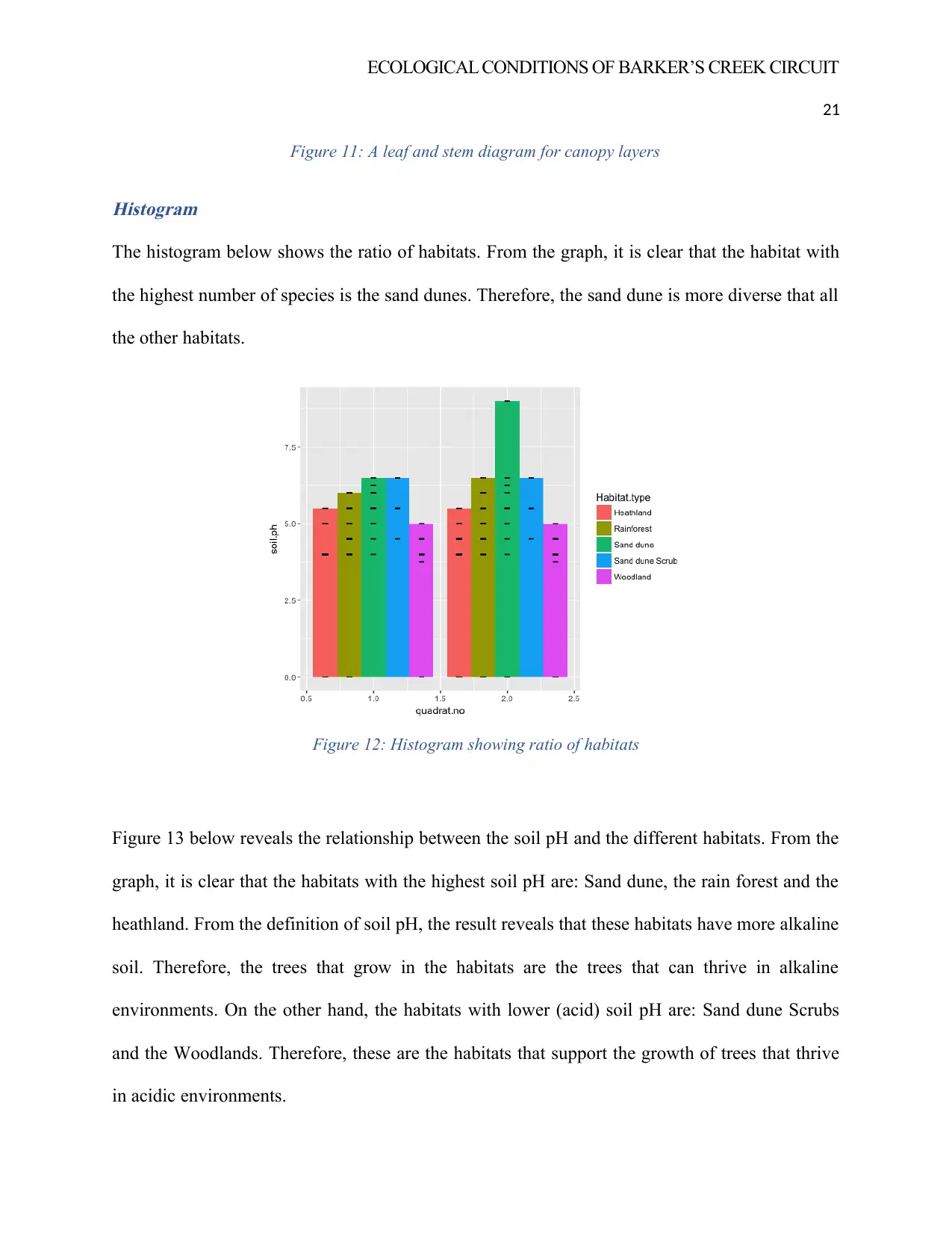
ECOLOGICAL CONDITIONS OF BARKER’S CREEK CIRCUIT
21
Figure 11: A leaf and stem diagram for canopy layers
Histogram
The histogram below shows the ratio of habitats. From the graph, it is clear that the habitat with
the highest number of species is the sand dunes. Therefore, the sand dune is more diverse that all
the other habitats.
Figure 12: Histogram showing ratio of habitats
Figure 13 below reveals the relationship between the soil pH and the different habitats. From the
graph, it is clear that the habitats with the highest soil pH are: Sand dune, the rain forest and the
heathland. From the definition of soil pH, the result reveals that these habitats have more alkaline
soil. Therefore, the trees that grow in the habitats are the trees that can thrive in alkaline
environments. On the other hand, the habitats with lower (acid) soil pH are: Sand dune Scrubs
and the Woodlands. Therefore, these are the habitats that support the growth of trees that thrive
in acidic environments.
21
Figure 11: A leaf and stem diagram for canopy layers
Histogram
The histogram below shows the ratio of habitats. From the graph, it is clear that the habitat with
the highest number of species is the sand dunes. Therefore, the sand dune is more diverse that all
the other habitats.
Figure 12: Histogram showing ratio of habitats
Figure 13 below reveals the relationship between the soil pH and the different habitats. From the
graph, it is clear that the habitats with the highest soil pH are: Sand dune, the rain forest and the
heathland. From the definition of soil pH, the result reveals that these habitats have more alkaline
soil. Therefore, the trees that grow in the habitats are the trees that can thrive in alkaline
environments. On the other hand, the habitats with lower (acid) soil pH are: Sand dune Scrubs
and the Woodlands. Therefore, these are the habitats that support the growth of trees that thrive
in acidic environments.
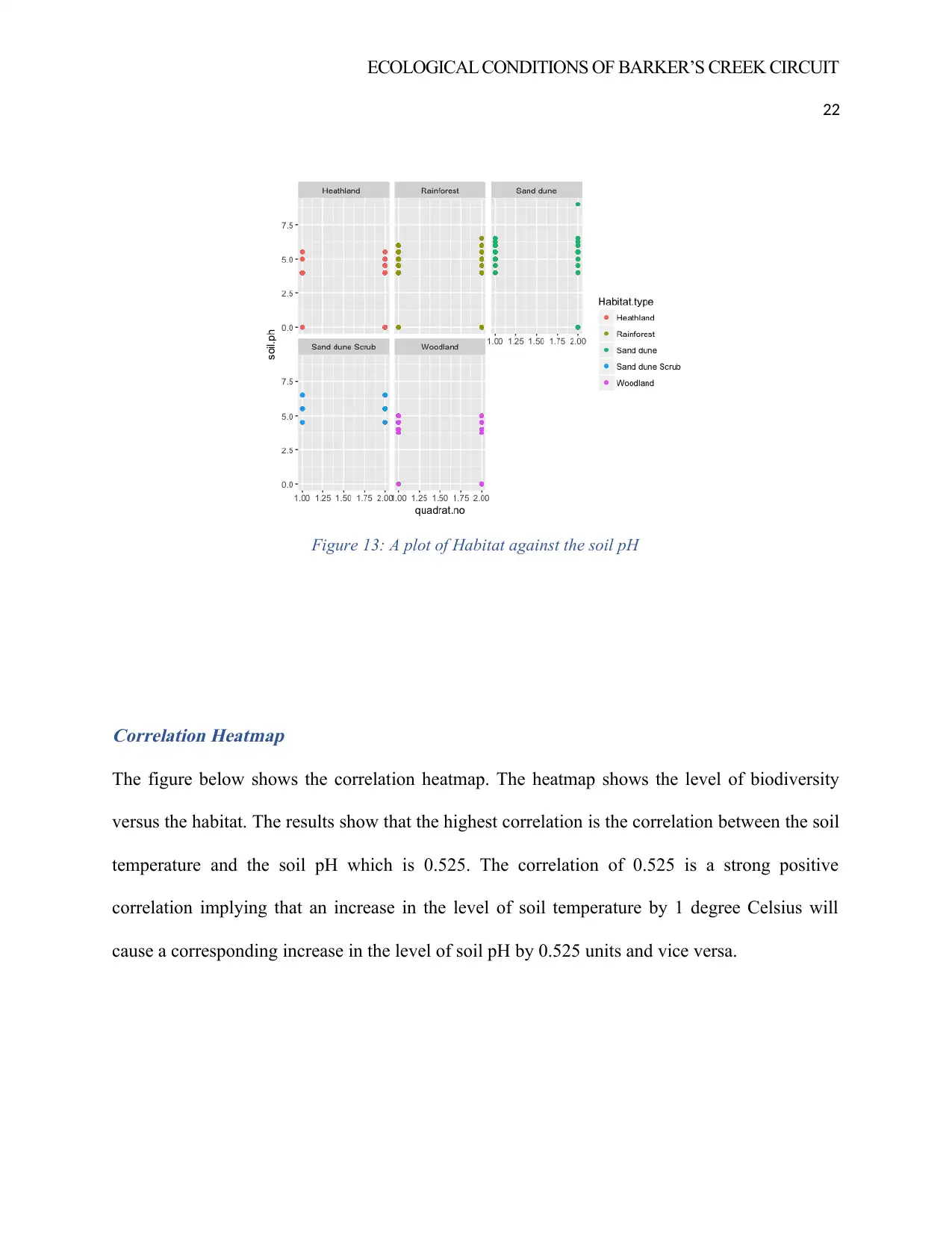
ECOLOGICAL CONDITIONS OF BARKER’S CREEK CIRCUIT
22
Figure 13: A plot of Habitat against the soil pH
Correlation Heatmap
The figure below shows the correlation heatmap. The heatmap shows the level of biodiversity
versus the habitat. The results show that the highest correlation is the correlation between the soil
temperature and the soil pH which is 0.525. The correlation of 0.525 is a strong positive
correlation implying that an increase in the level of soil temperature by 1 degree Celsius will
cause a corresponding increase in the level of soil pH by 0.525 units and vice versa.
22
Figure 13: A plot of Habitat against the soil pH
Correlation Heatmap
The figure below shows the correlation heatmap. The heatmap shows the level of biodiversity
versus the habitat. The results show that the highest correlation is the correlation between the soil
temperature and the soil pH which is 0.525. The correlation of 0.525 is a strong positive
correlation implying that an increase in the level of soil temperature by 1 degree Celsius will
cause a corresponding increase in the level of soil pH by 0.525 units and vice versa.
Secure Best Marks with AI Grader
Need help grading? Try our AI Grader for instant feedback on your assignments.
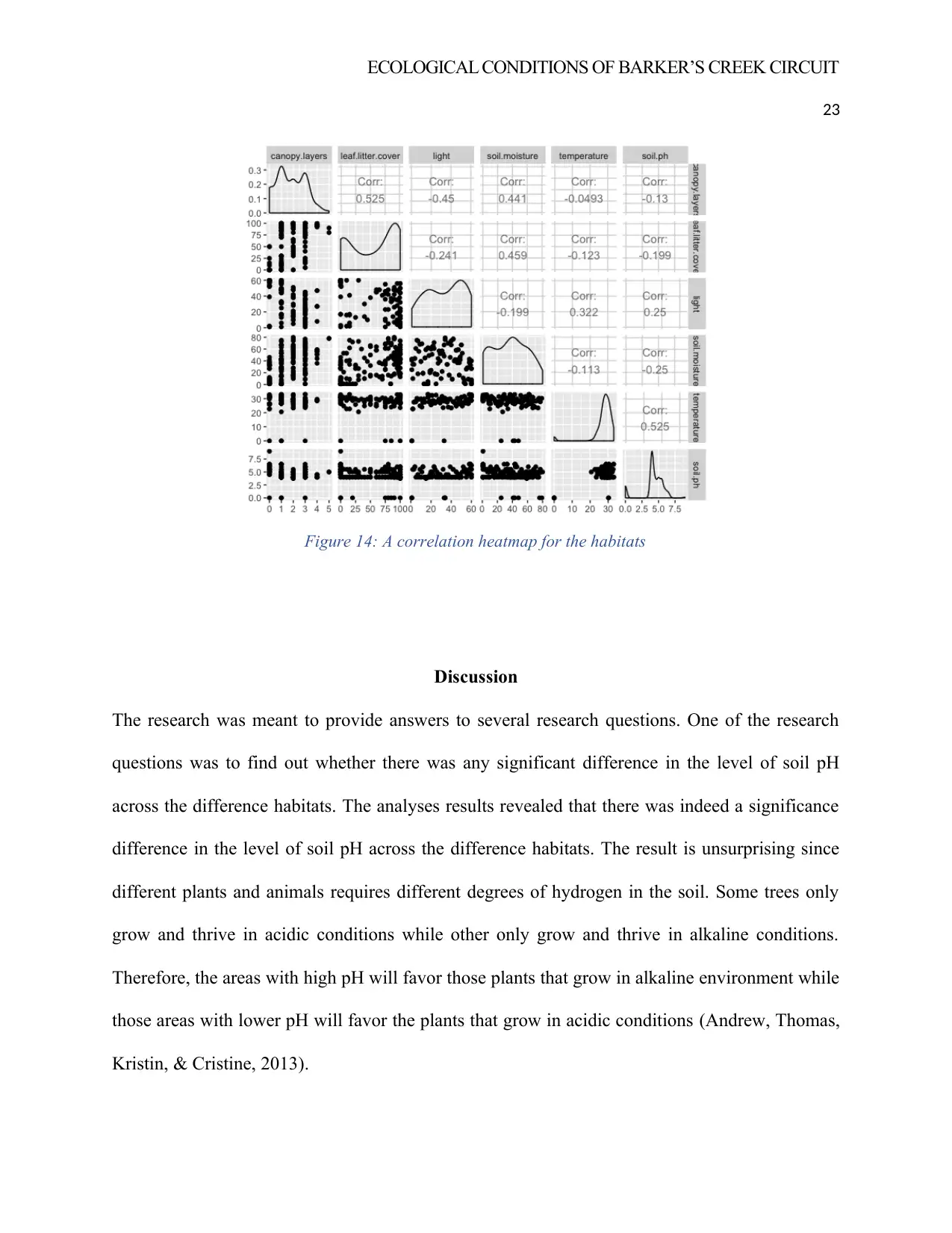
ECOLOGICAL CONDITIONS OF BARKER’S CREEK CIRCUIT
23
Figure 14: A correlation heatmap for the habitats
Discussion
The research was meant to provide answers to several research questions. One of the research
questions was to find out whether there was any significant difference in the level of soil pH
across the difference habitats. The analyses results revealed that there was indeed a significance
difference in the level of soil pH across the difference habitats. The result is unsurprising since
different plants and animals requires different degrees of hydrogen in the soil. Some trees only
grow and thrive in acidic conditions while other only grow and thrive in alkaline conditions.
Therefore, the areas with high pH will favor those plants that grow in alkaline environment while
those areas with lower pH will favor the plants that grow in acidic conditions (Andrew, Thomas,
Kristin, & Cristine, 2013).
23
Figure 14: A correlation heatmap for the habitats
Discussion
The research was meant to provide answers to several research questions. One of the research
questions was to find out whether there was any significant difference in the level of soil pH
across the difference habitats. The analyses results revealed that there was indeed a significance
difference in the level of soil pH across the difference habitats. The result is unsurprising since
different plants and animals requires different degrees of hydrogen in the soil. Some trees only
grow and thrive in acidic conditions while other only grow and thrive in alkaline conditions.
Therefore, the areas with high pH will favor those plants that grow in alkaline environment while
those areas with lower pH will favor the plants that grow in acidic conditions (Andrew, Thomas,
Kristin, & Cristine, 2013).
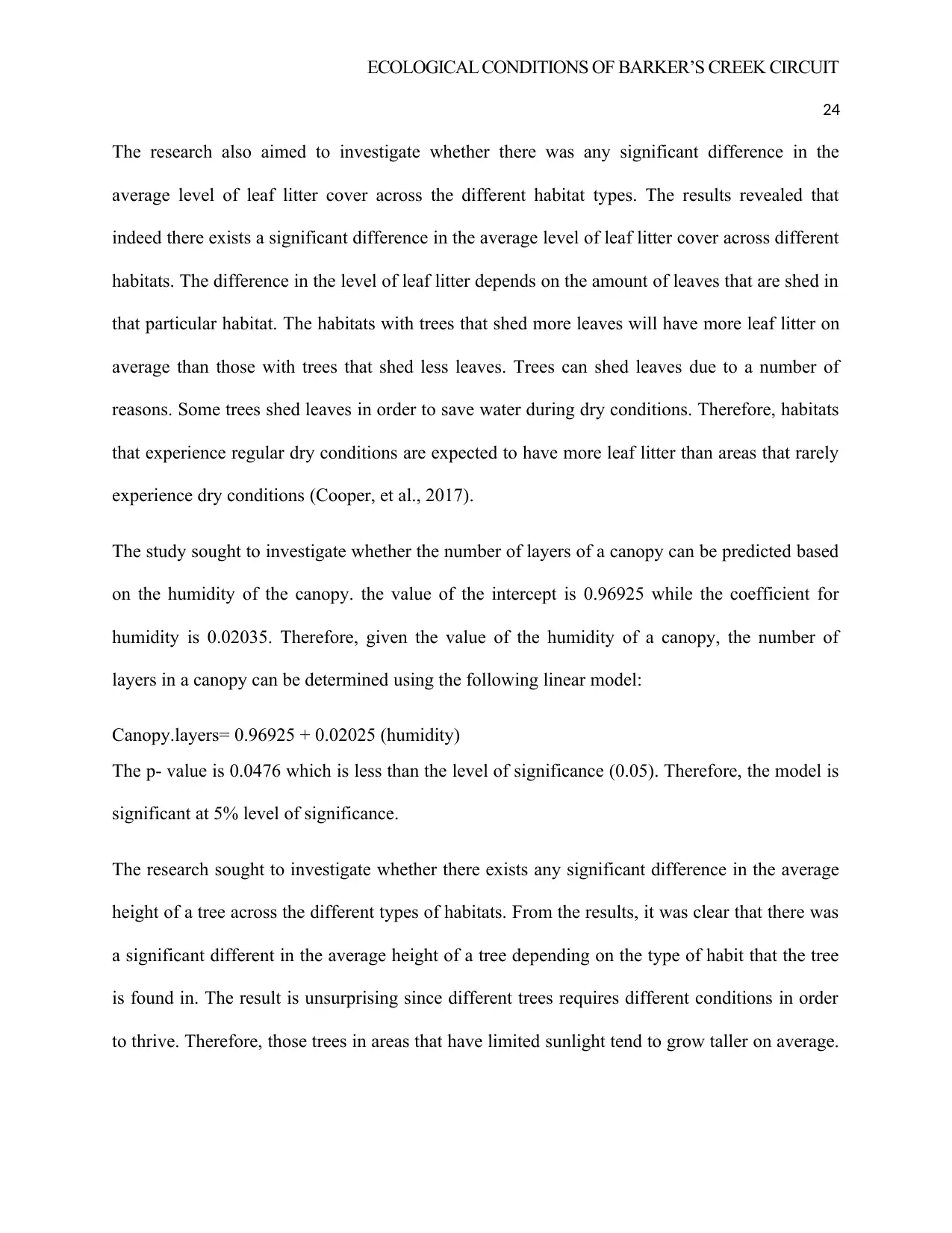
ECOLOGICAL CONDITIONS OF BARKER’S CREEK CIRCUIT
24
The research also aimed to investigate whether there was any significant difference in the
average level of leaf litter cover across the different habitat types. The results revealed that
indeed there exists a significant difference in the average level of leaf litter cover across different
habitats. The difference in the level of leaf litter depends on the amount of leaves that are shed in
that particular habitat. The habitats with trees that shed more leaves will have more leaf litter on
average than those with trees that shed less leaves. Trees can shed leaves due to a number of
reasons. Some trees shed leaves in order to save water during dry conditions. Therefore, habitats
that experience regular dry conditions are expected to have more leaf litter than areas that rarely
experience dry conditions (Cooper, et al., 2017).
The study sought to investigate whether the number of layers of a canopy can be predicted based
on the humidity of the canopy. the value of the intercept is 0.96925 while the coefficient for
humidity is 0.02035. Therefore, given the value of the humidity of a canopy, the number of
layers in a canopy can be determined using the following linear model:
Canopy.layers= 0.96925 + 0.02025 (humidity)
The p- value is 0.0476 which is less than the level of significance (0.05). Therefore, the model is
significant at 5% level of significance.
The research sought to investigate whether there exists any significant difference in the average
height of a tree across the different types of habitats. From the results, it was clear that there was
a significant different in the average height of a tree depending on the type of habit that the tree
is found in. The result is unsurprising since different trees requires different conditions in order
to thrive. Therefore, those trees in areas that have limited sunlight tend to grow taller on average.
24
The research also aimed to investigate whether there was any significant difference in the
average level of leaf litter cover across the different habitat types. The results revealed that
indeed there exists a significant difference in the average level of leaf litter cover across different
habitats. The difference in the level of leaf litter depends on the amount of leaves that are shed in
that particular habitat. The habitats with trees that shed more leaves will have more leaf litter on
average than those with trees that shed less leaves. Trees can shed leaves due to a number of
reasons. Some trees shed leaves in order to save water during dry conditions. Therefore, habitats
that experience regular dry conditions are expected to have more leaf litter than areas that rarely
experience dry conditions (Cooper, et al., 2017).
The study sought to investigate whether the number of layers of a canopy can be predicted based
on the humidity of the canopy. the value of the intercept is 0.96925 while the coefficient for
humidity is 0.02035. Therefore, given the value of the humidity of a canopy, the number of
layers in a canopy can be determined using the following linear model:
Canopy.layers= 0.96925 + 0.02025 (humidity)
The p- value is 0.0476 which is less than the level of significance (0.05). Therefore, the model is
significant at 5% level of significance.
The research sought to investigate whether there exists any significant difference in the average
height of a tree across the different types of habitats. From the results, it was clear that there was
a significant different in the average height of a tree depending on the type of habit that the tree
is found in. The result is unsurprising since different trees requires different conditions in order
to thrive. Therefore, those trees in areas that have limited sunlight tend to grow taller on average.
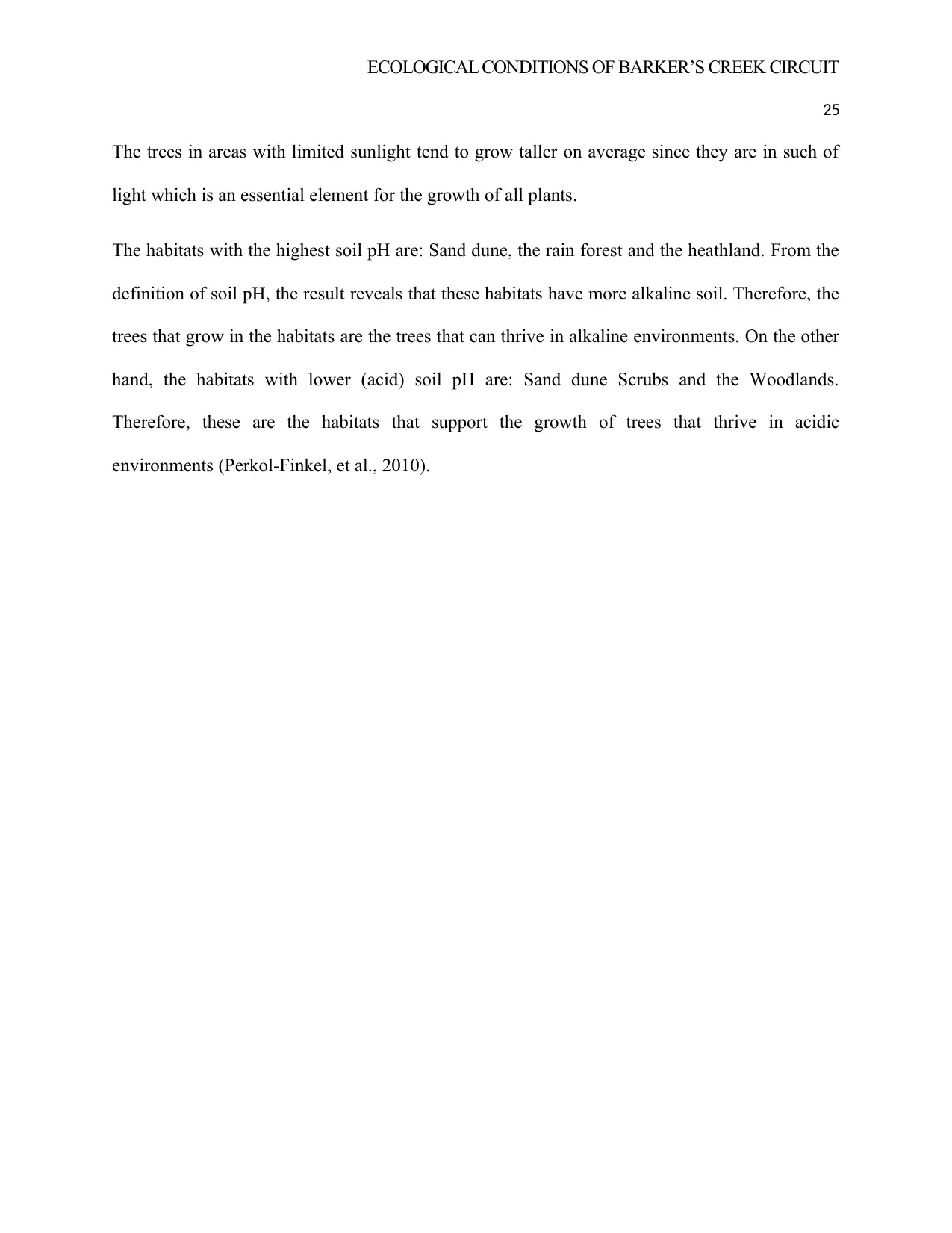
ECOLOGICAL CONDITIONS OF BARKER’S CREEK CIRCUIT
25
The trees in areas with limited sunlight tend to grow taller on average since they are in such of
light which is an essential element for the growth of all plants.
The habitats with the highest soil pH are: Sand dune, the rain forest and the heathland. From the
definition of soil pH, the result reveals that these habitats have more alkaline soil. Therefore, the
trees that grow in the habitats are the trees that can thrive in alkaline environments. On the other
hand, the habitats with lower (acid) soil pH are: Sand dune Scrubs and the Woodlands.
Therefore, these are the habitats that support the growth of trees that thrive in acidic
environments (Perkol-Finkel, et al., 2010).
25
The trees in areas with limited sunlight tend to grow taller on average since they are in such of
light which is an essential element for the growth of all plants.
The habitats with the highest soil pH are: Sand dune, the rain forest and the heathland. From the
definition of soil pH, the result reveals that these habitats have more alkaline soil. Therefore, the
trees that grow in the habitats are the trees that can thrive in alkaline environments. On the other
hand, the habitats with lower (acid) soil pH are: Sand dune Scrubs and the Woodlands.
Therefore, these are the habitats that support the growth of trees that thrive in acidic
environments (Perkol-Finkel, et al., 2010).
Paraphrase This Document
Need a fresh take? Get an instant paraphrase of this document with our AI Paraphraser
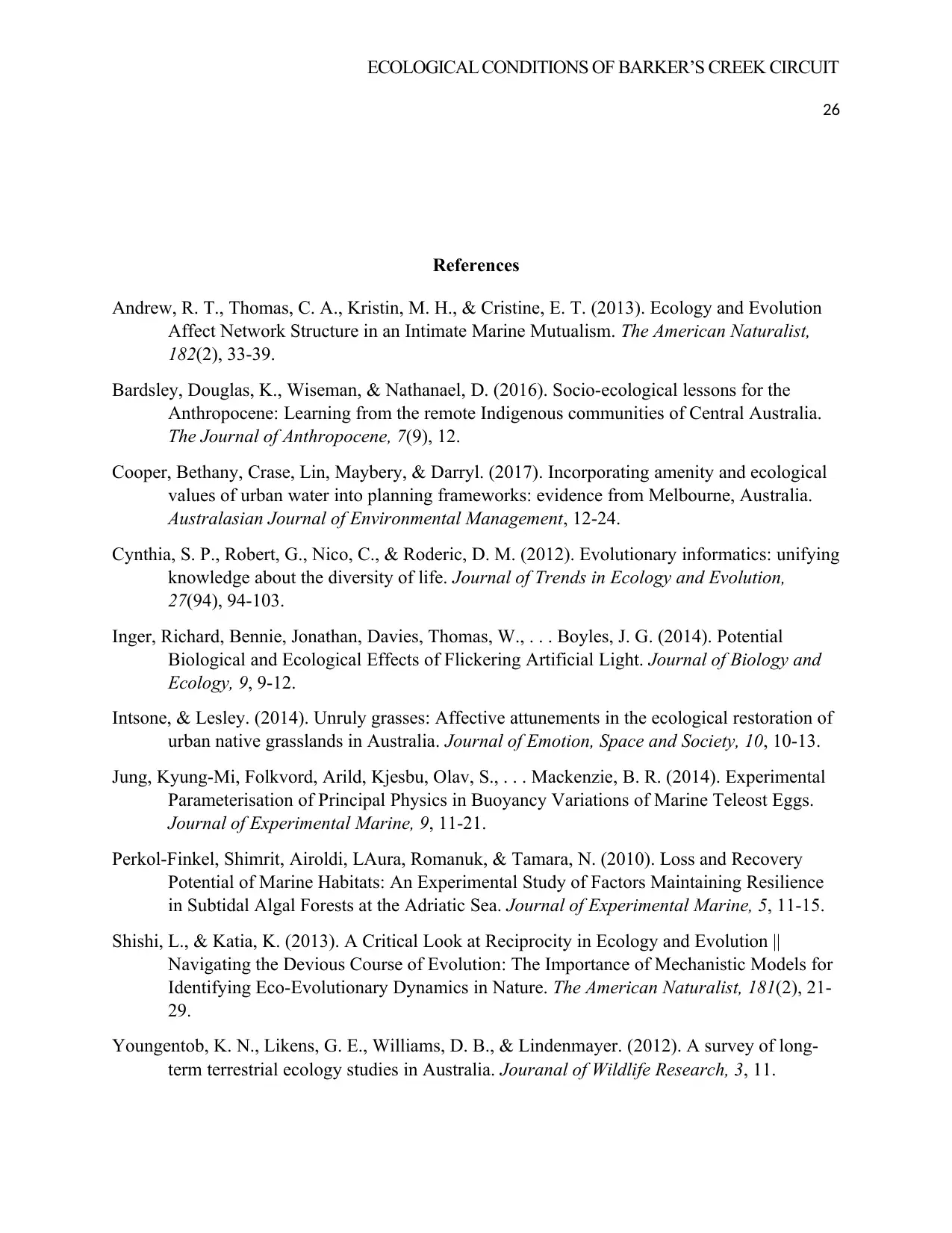
ECOLOGICAL CONDITIONS OF BARKER’S CREEK CIRCUIT
26
References
Andrew, R. T., Thomas, C. A., Kristin, M. H., & Cristine, E. T. (2013). Ecology and Evolution
Affect Network Structure in an Intimate Marine Mutualism. The American Naturalist,
182(2), 33-39.
Bardsley, Douglas, K., Wiseman, & Nathanael, D. (2016). Socio-ecological lessons for the
Anthropocene: Learning from the remote Indigenous communities of Central Australia.
The Journal of Anthropocene, 7(9), 12.
Cooper, Bethany, Crase, Lin, Maybery, & Darryl. (2017). Incorporating amenity and ecological
values of urban water into planning frameworks: evidence from Melbourne, Australia.
Australasian Journal of Environmental Management, 12-24.
Cynthia, S. P., Robert, G., Nico, C., & Roderic, D. M. (2012). Evolutionary informatics: unifying
knowledge about the diversity of life. Journal of Trends in Ecology and Evolution,
27(94), 94-103.
Inger, Richard, Bennie, Jonathan, Davies, Thomas, W., . . . Boyles, J. G. (2014). Potential
Biological and Ecological Effects of Flickering Artificial Light. Journal of Biology and
Ecology, 9, 9-12.
Intsone, & Lesley. (2014). Unruly grasses: Affective attunements in the ecological restoration of
urban native grasslands in Australia. Journal of Emotion, Space and Society, 10, 10-13.
Jung, Kyung-Mi, Folkvord, Arild, Kjesbu, Olav, S., . . . Mackenzie, B. R. (2014). Experimental
Parameterisation of Principal Physics in Buoyancy Variations of Marine Teleost Eggs.
Journal of Experimental Marine, 9, 11-21.
Perkol-Finkel, Shimrit, Airoldi, LAura, Romanuk, & Tamara, N. (2010). Loss and Recovery
Potential of Marine Habitats: An Experimental Study of Factors Maintaining Resilience
in Subtidal Algal Forests at the Adriatic Sea. Journal of Experimental Marine, 5, 11-15.
Shishi, L., & Katia, K. (2013). A Critical Look at Reciprocity in Ecology and Evolution ||
Navigating the Devious Course of Evolution: The Importance of Mechanistic Models for
Identifying Eco-Evolutionary Dynamics in Nature. The American Naturalist, 181(2), 21-
29.
Youngentob, K. N., Likens, G. E., Williams, D. B., & Lindenmayer. (2012). A survey of long-
term terrestrial ecology studies in Australia. Jouranal of Wildlife Research, 3, 11.
26
References
Andrew, R. T., Thomas, C. A., Kristin, M. H., & Cristine, E. T. (2013). Ecology and Evolution
Affect Network Structure in an Intimate Marine Mutualism. The American Naturalist,
182(2), 33-39.
Bardsley, Douglas, K., Wiseman, & Nathanael, D. (2016). Socio-ecological lessons for the
Anthropocene: Learning from the remote Indigenous communities of Central Australia.
The Journal of Anthropocene, 7(9), 12.
Cooper, Bethany, Crase, Lin, Maybery, & Darryl. (2017). Incorporating amenity and ecological
values of urban water into planning frameworks: evidence from Melbourne, Australia.
Australasian Journal of Environmental Management, 12-24.
Cynthia, S. P., Robert, G., Nico, C., & Roderic, D. M. (2012). Evolutionary informatics: unifying
knowledge about the diversity of life. Journal of Trends in Ecology and Evolution,
27(94), 94-103.
Inger, Richard, Bennie, Jonathan, Davies, Thomas, W., . . . Boyles, J. G. (2014). Potential
Biological and Ecological Effects of Flickering Artificial Light. Journal of Biology and
Ecology, 9, 9-12.
Intsone, & Lesley. (2014). Unruly grasses: Affective attunements in the ecological restoration of
urban native grasslands in Australia. Journal of Emotion, Space and Society, 10, 10-13.
Jung, Kyung-Mi, Folkvord, Arild, Kjesbu, Olav, S., . . . Mackenzie, B. R. (2014). Experimental
Parameterisation of Principal Physics in Buoyancy Variations of Marine Teleost Eggs.
Journal of Experimental Marine, 9, 11-21.
Perkol-Finkel, Shimrit, Airoldi, LAura, Romanuk, & Tamara, N. (2010). Loss and Recovery
Potential of Marine Habitats: An Experimental Study of Factors Maintaining Resilience
in Subtidal Algal Forests at the Adriatic Sea. Journal of Experimental Marine, 5, 11-15.
Shishi, L., & Katia, K. (2013). A Critical Look at Reciprocity in Ecology and Evolution ||
Navigating the Devious Course of Evolution: The Importance of Mechanistic Models for
Identifying Eco-Evolutionary Dynamics in Nature. The American Naturalist, 181(2), 21-
29.
Youngentob, K. N., Likens, G. E., Williams, D. B., & Lindenmayer. (2012). A survey of long-
term terrestrial ecology studies in Australia. Jouranal of Wildlife Research, 3, 11.

ECOLOGICAL CONDITIONS OF BARKER’S CREEK CIRCUIT
27
27
1 out of 27
Related Documents
Your All-in-One AI-Powered Toolkit for Academic Success.
+13062052269
info@desklib.com
Available 24*7 on WhatsApp / Email
![[object Object]](/_next/static/media/star-bottom.7253800d.svg)
Unlock your academic potential
© 2024 | Zucol Services PVT LTD | All rights reserved.





